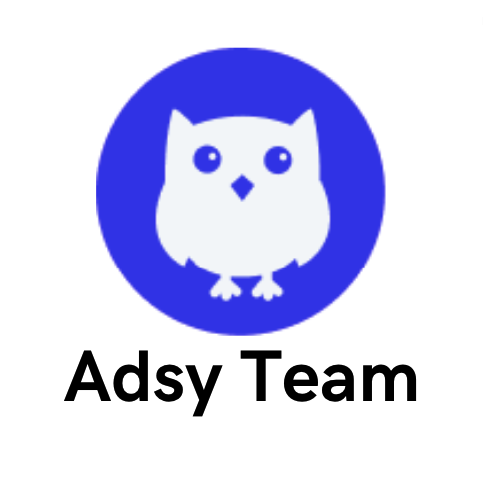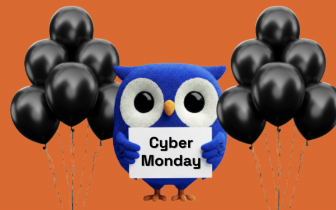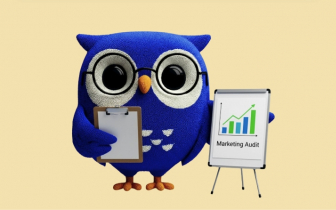17 Best Advertising Platforms: Which Ones Do You Actually Need?
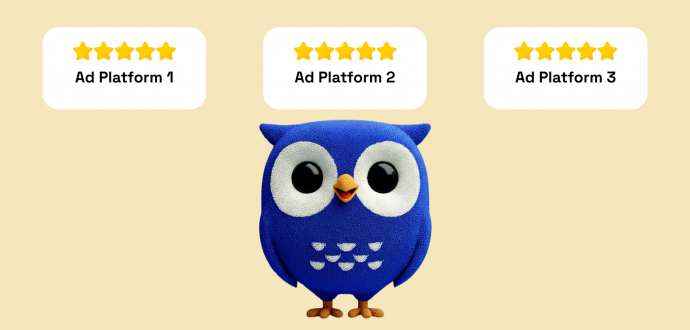
Every year, the number of advertising channels seems to grow. Add in an expanding list of ad formats (video ads, shopping ads, carousel ads), and it’s really easy to get lost.
But does your business need all of them?
Hardly. The best online advertising platforms are not a checklist you have to fill in. They’re the ones that fit your business goals and work for your target audience. On top of it, they have to match your available resources.
But of course, it is easier said than done.
That’s why we’ve created this guide. Today, we’ll:
- Walk you through 17 of the best ad platforms,
- Explain who they’re really for,
- And help you decide which ones deserve your ad spend.
Why you don’t need every advertising platform
The marketing world loves to sell you panic: if you’re not on Pinterest (or whatever the channel of the week is), you’ll vanish into obscurity. Truth is, that’s not how it works.
It’s just good old-fashioned FOMO pretending to be a strategy.

It’s easy to assume that because your customers use many different social media, you need to advertise on all of them.
In practice, this approach... rarely works.
- First of all, you probably don't have an unlimited budget to run ads on every available platform.
- Secondly, it leads to a huge drain of your team’s resources and time.
- And ultimately, running campaigns through multiple channels without focus actually leads to lower engagement.
You know how it goes. If you try to be everywhere, you end up being nowhere.
What is the smarter approach?
Only use ad solutions that make sense for your specific business goals:
- Looking for direct sales? Shopping ads on Google or Bing may drive more traffic than promoted posts on Twitter.
- Want to reach a professional audience with precise targeting by job title? LinkedIn Ads are built for that.
- Need to engage Gen Z with some fresh creatives? TikTok Ads with a branded hashtag challenge can easily outperform traditional formats.
The goal is not to cover every single channel, but to cover the right ones. So, bottom line: focus on value, not quantity.
17 best online advertising platforms (by type)
When it comes to choosing top online advertising platforms, nothing works better than a good system. That’s why we sorted all the most popular options by type, so you can navigate through them easily.
We’ll cover ad channels in the following categories:
- Search,
- Social media,
- E-commerce and retail,
- Niche options,
- Display,
- And messengers.
Search advertising
1. Google Ads
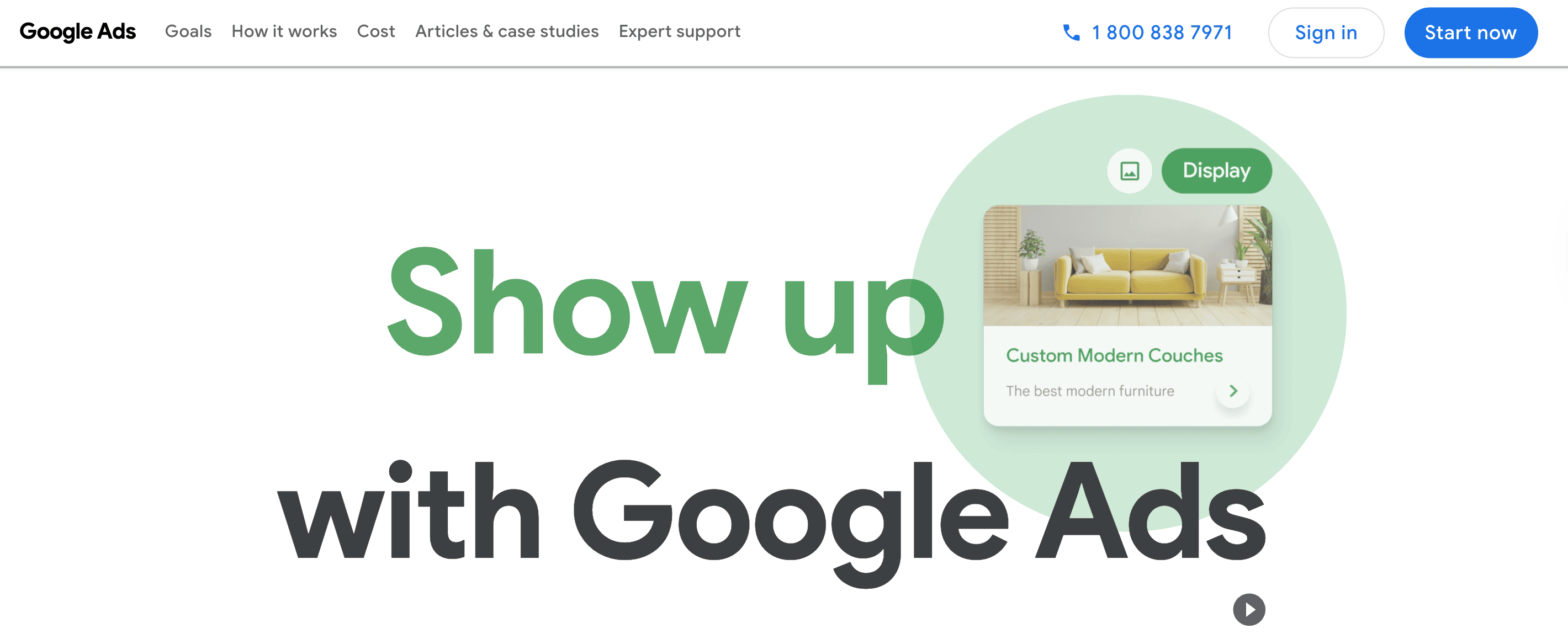
Source: Google
If you had to pick just one online advertising platform, Google Ads would likely be it. Why? The answer is simple: Google has over 90% of the global search market.

Source: Statcounter
Therefore, it captures an audience that most businesses can’t afford to ignore. After all, it remains the benchmark for paid search.
Besides, Google Ads also allows you to create very different ad campaigns. Apart from the typical sponsored results in search, you can appear in your audience’s Maps, Gmail, YouTube, and Google Play.
Best use cases:
- Driving direct sales with shopping ads (especially for e-commerce).
- Capturing high-intent customers searching for your products/services.
- Running local campaigns to target customers near your physical business.
- Testing multiple ad formats to see what's working and what's not.
Why it works: Google Ads lets you target users by keyword, location, device, and even time of day. If you optimize well, ad spend here can bring measurable leads and sales. And you can be almost everywhere. This is why, for most businesses, it’s the backbone of online advertising.
2. Microsoft Ads
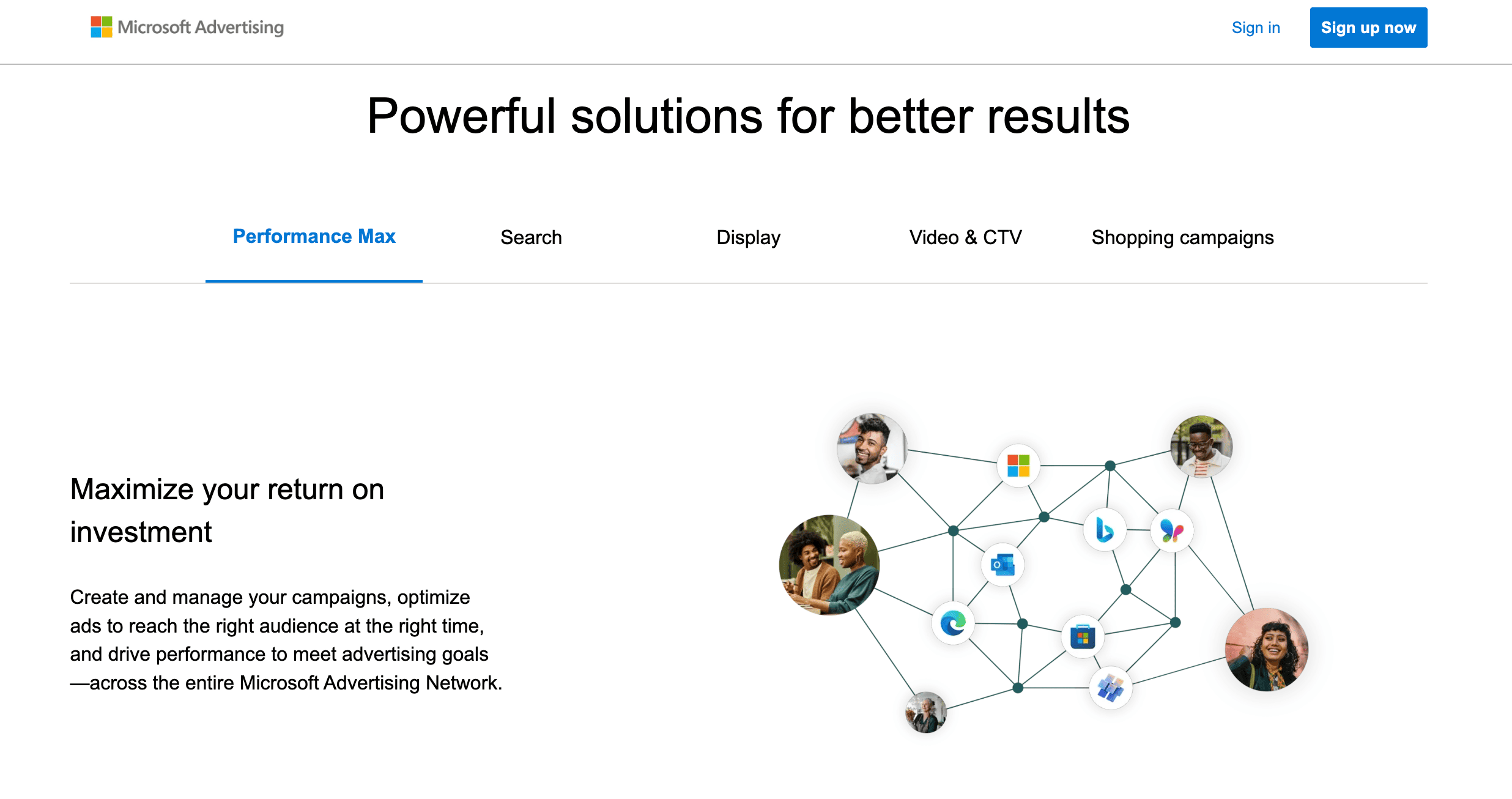
Source: Microsoft
Microsoft Ads (formerly Bing Ads) may not have the volume of Google, but it holds surprising value. Often, it’s believed that if your target audience is slightly older, more professional, or more affluent, Microsoft Ads is a good choice.
It’s quite popular among B2B businesses, and it’s for a good reason. If we take a look at Microsoft’s official data about users on the Microsoft Advertising Network for Search, we’ll see an interesting picture:
- You can potentially have access to 52% decision makers and 26% executives.
- While 46% of users have a household income in the top 25%.
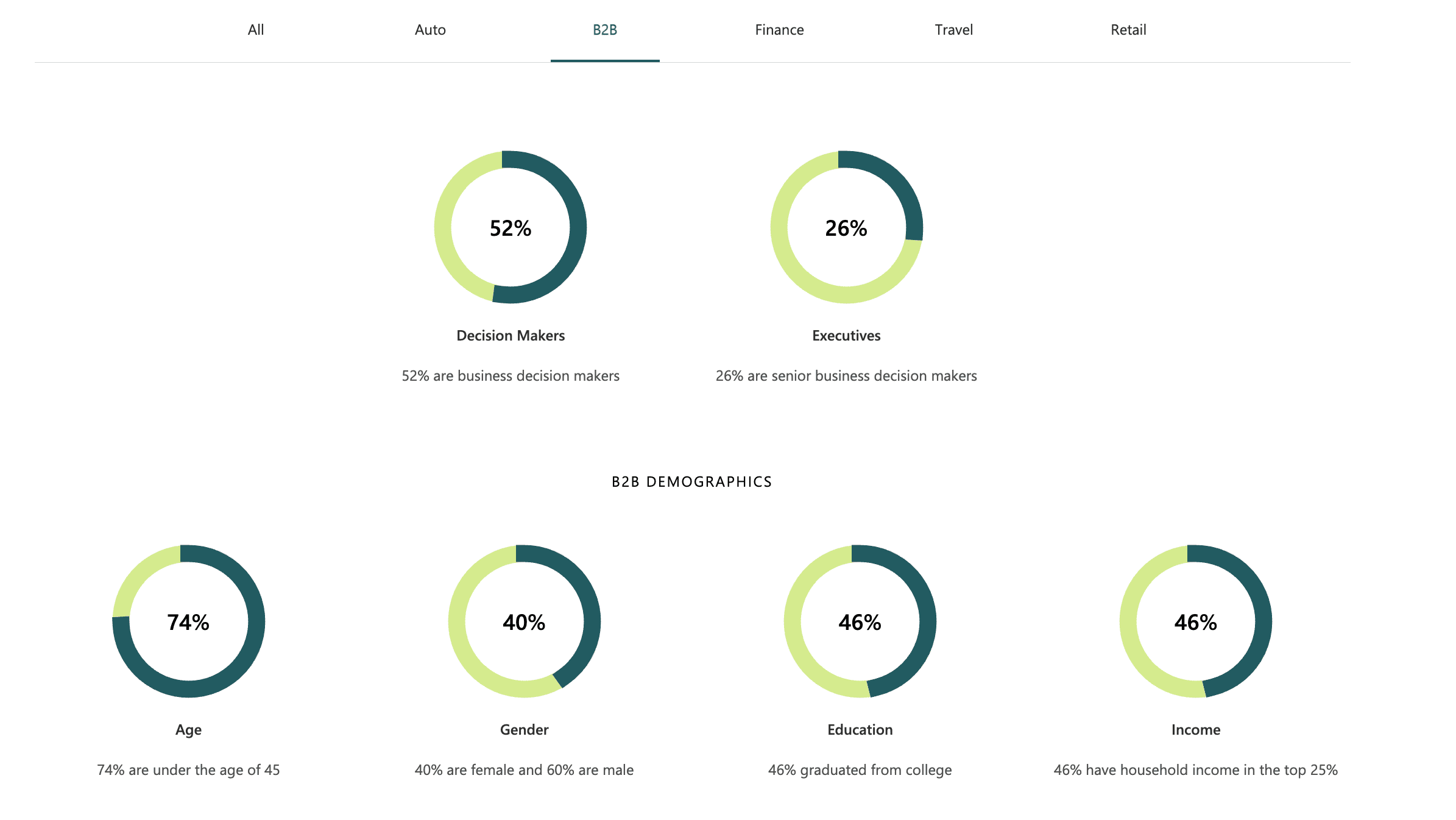
Source: Microsoft
Of course, this data isn’t a rule, but more of a tendency. Still, many businesses tend to use Microsoft Ads over Google Ads when they want to access a more professional and niche user base.
Best use cases:
- Popular for B2B businesses (makes sense based on the data above).
- Since many companies use Microsoft products at work, you can target some professionals more easily.
- Focusing on niche industries where Google Ads are too expensive because of high competition.
Why it works: Because fewer businesses advertise here, your campaigns can stretch further. Besides, you can find a more appropriate audience for your paid ads, depending on your industry.
Social media
It’s often believed that search ads are about capturing intent. What's social media advertising, then? We say it is all about discovery.
Normally, people don’t open Facebook, Instagram, or TikTok to buy a product immediately. And yet, with the right ad formats and targeting, you can attract engaged customers who could eventually become your loyal customers.
3. Facebook Ads
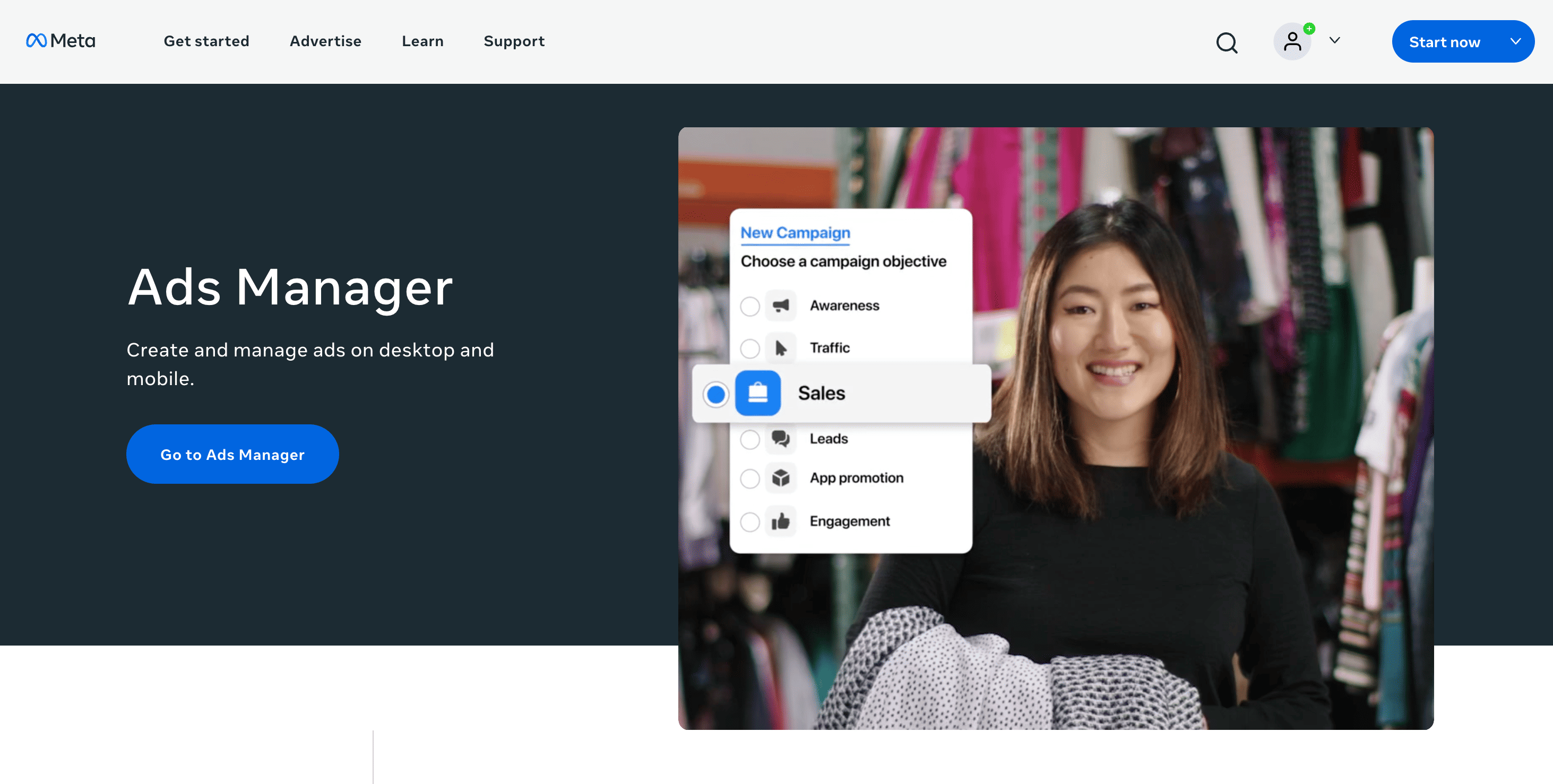
Source: Ads Facebook
Facebook was, and continues to be, one of the best advertising platforms. Simply because people keep using it, and it has evolved into a marketplace for different demographics. Businesses can target audiences by age, interests, or even life events.
While most of its users are under 34, Facebook gives you access to one of the largest pools of people who are between 35 and 54. This would be quite complicated to find elsewhere on social media.
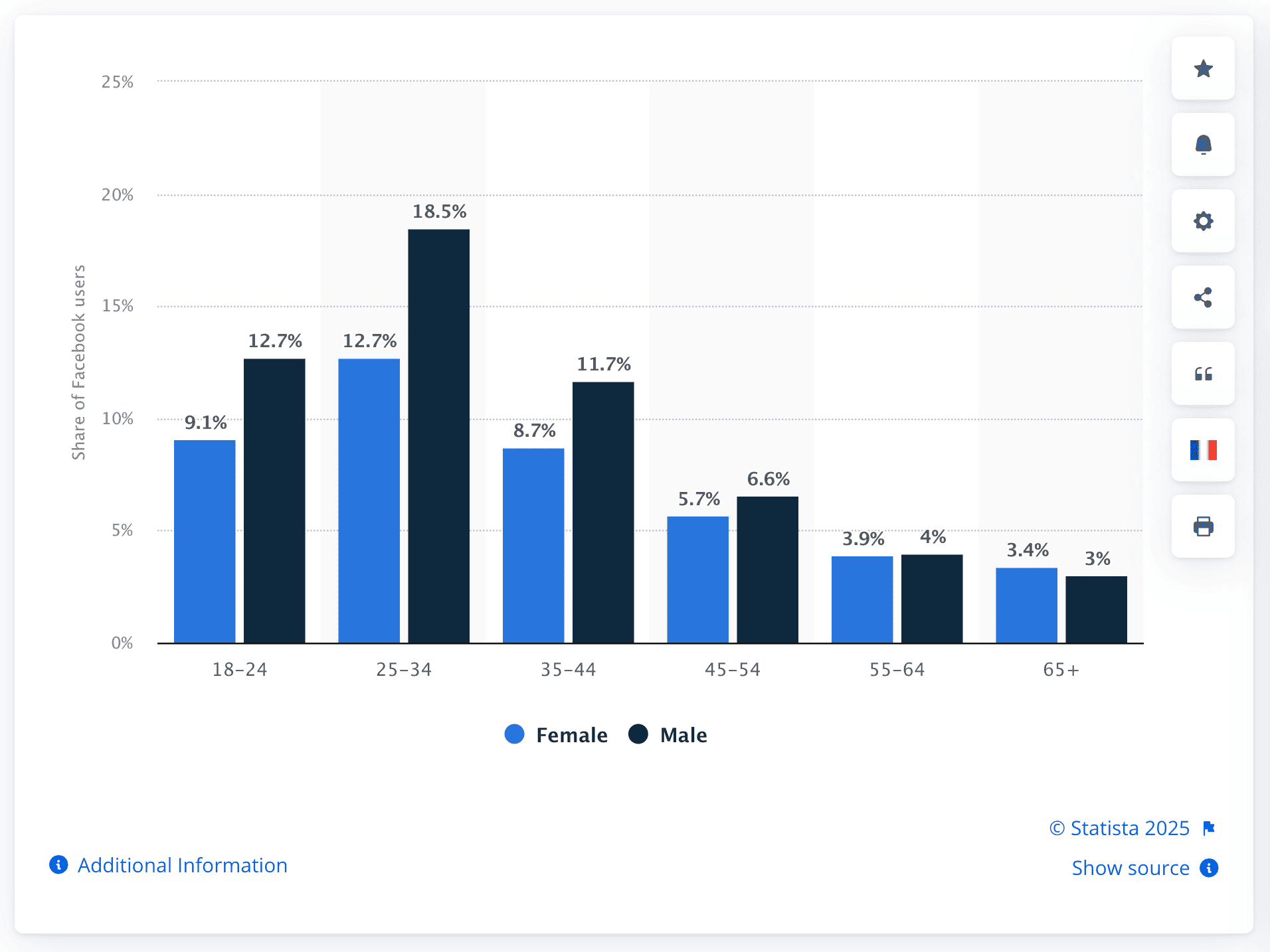
Source: Statista
Best use cases:
- Lead gen forms for potential customers.
- Local businesses can run highly targeted campaigns around a specific location.
- Dynamic ads retarget users with products they’ve already viewed on your site, which is good for e-commerce.
Why it works: Facebook Ads thrive because of the tons of data at their disposal. That’s exactly why you can target users even by their behaviors (e.g., frequent travelers) or life events (e.g., recently engaged).
Thanks to all this data, you can reach a very precise audience similar to your best customers. And then, retarget visitors who have engaged with your business page.
For most companies, it’s still one of the best platforms to run ads when it comes to cost-effectiveness and reaching potential customers at scale.
4. Instagram Ads
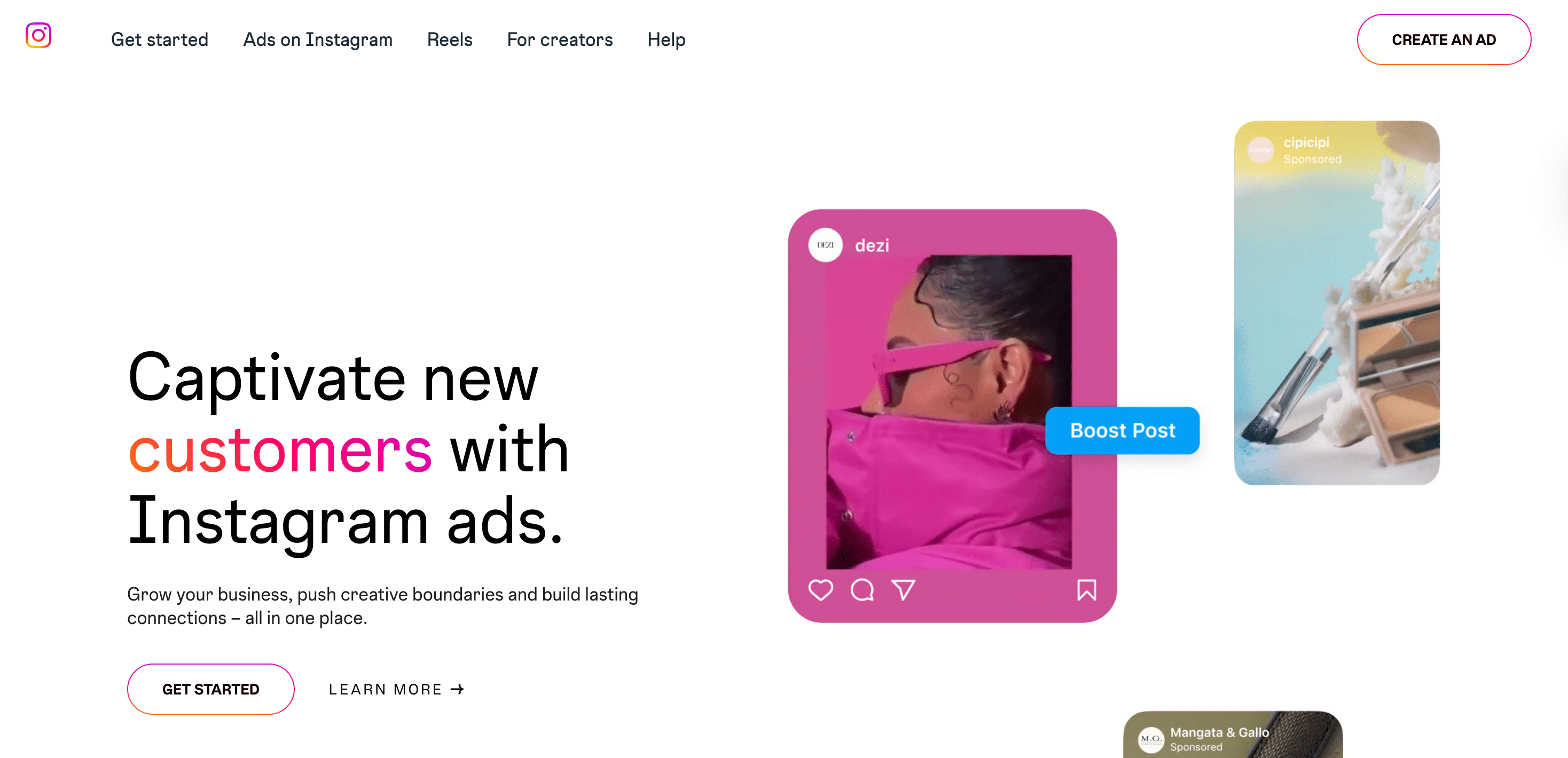
Source: Instagram
Instagram, owned by Meta, is a completely different story. It offers access to over 2 billion monthly active users, many of whom are younger. Generally, this audience is also more visually driven than the average Facebook user.
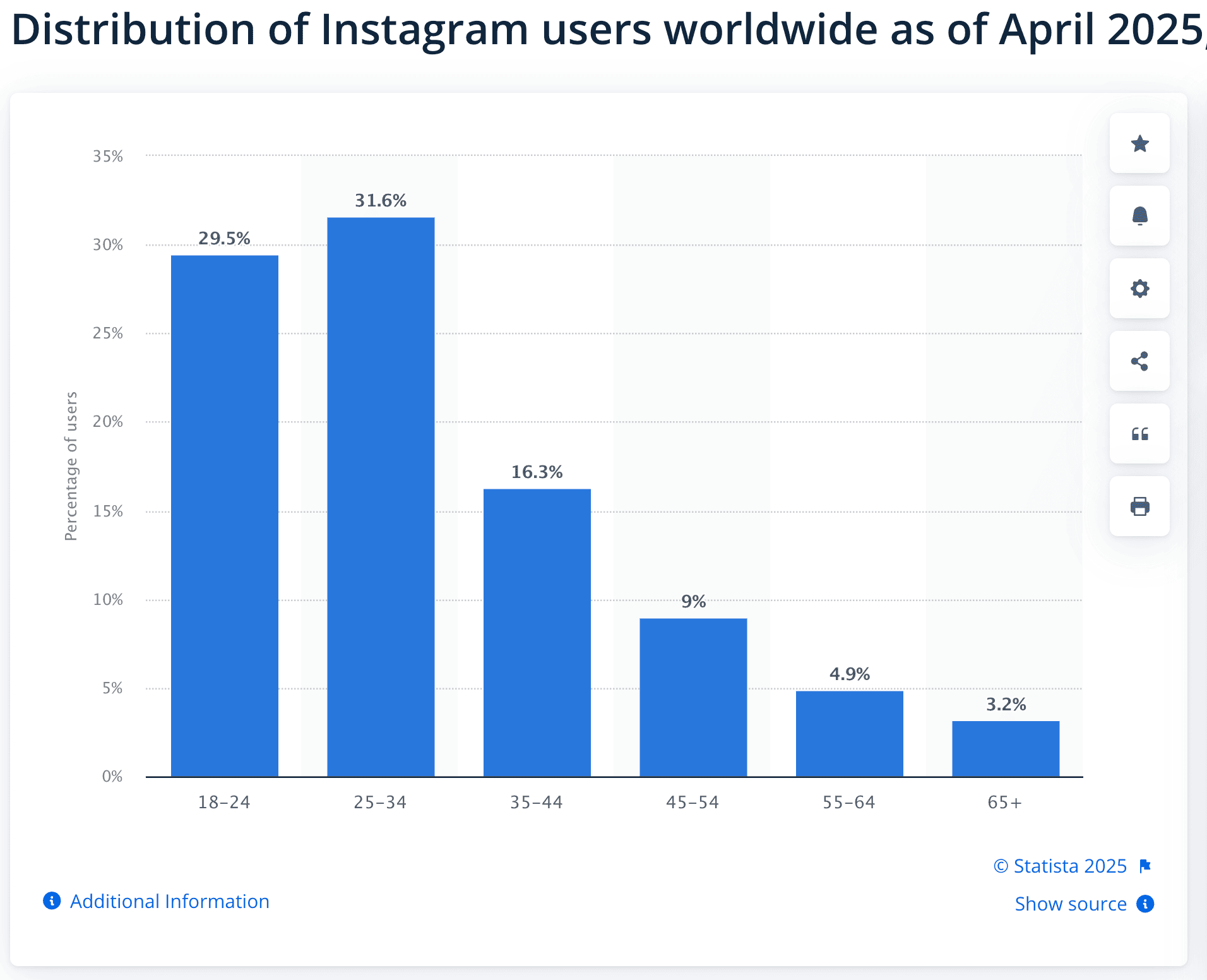
Source: Statista
Instagram Ads run through the same Meta Ads Manager, but this channel has its own culture and strengths. It’s all about more polished visuals, influencer-driven content, and higher engagement rates per post compared to Facebook (4x higher, according to some sources).
An attractive element for many is the variety of ad formats. You can work with images, videos, Stories, Reels, carousel collection ads, explore ads, and shopping ads integrated into product catalogs.
Best use cases:
- Lifestyle and visual brands are thriving here. Fashion, beauty, food, fitness, and travel brands perform exceptionally well with Instagram users.
- Product discovery has been one of the main things brands use on Instagram. It’s really handy that potential customers can browse and purchase directly from posts.
- Engagement campaigns are inherent to the very idea of Instagram. Reels and promoted posts are great for boosting follower count and interaction.
- Gen Z and Millennials are the main audiences here. So, if you target these demographics, it’s a good option to test.
Why it works: Instagram’s power lies in its ability to merge content and commerce. Businesses can run ads that are native to the platform. Short, eye-catching videos and carousel ads are some of the most popular and effective options.
With creativity and an understanding of your target audience, Instagram Ads can help you build brand credibility and get more customers.
5. TikTok Ads
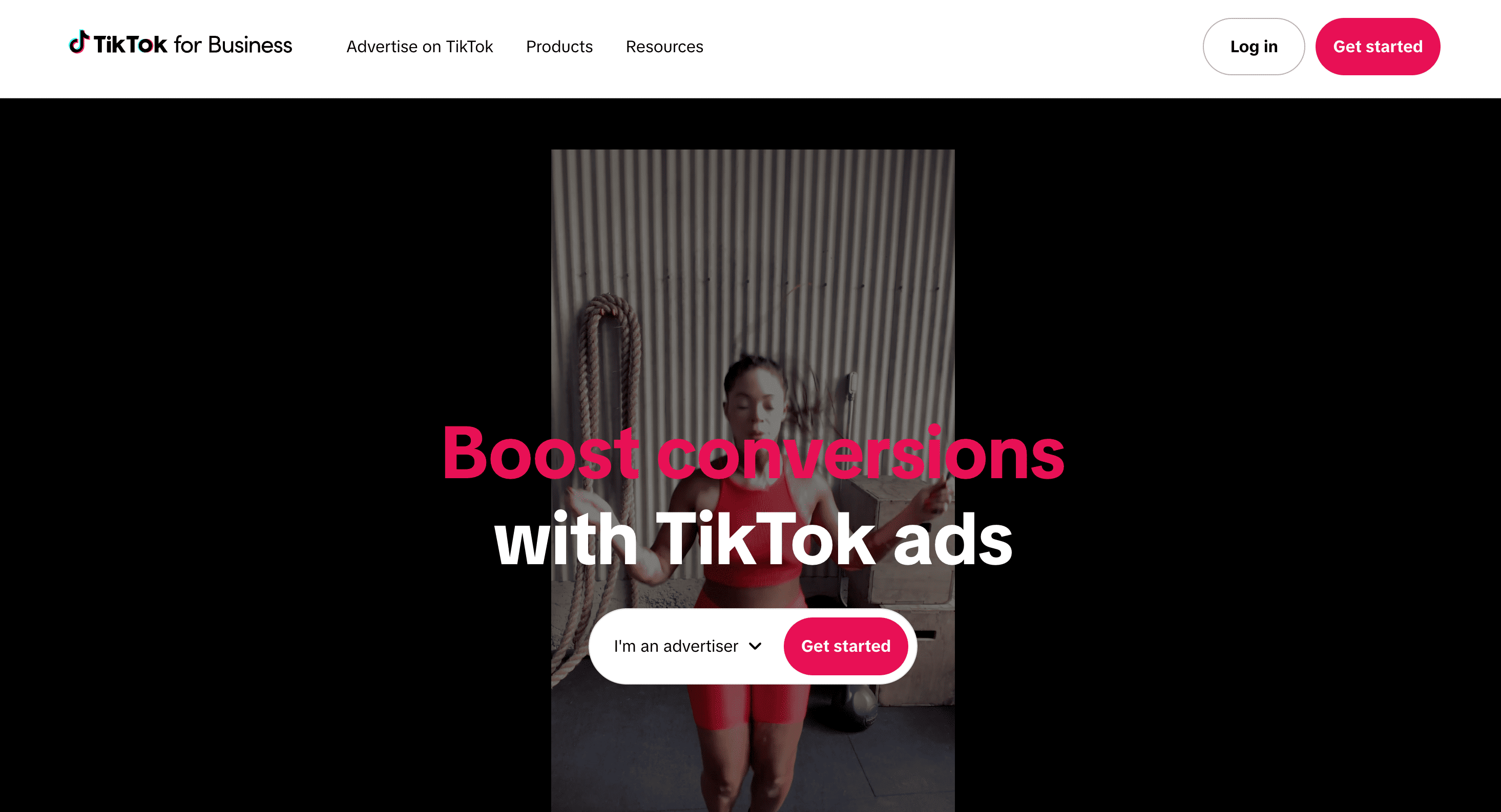
Source: TikTok
TikTok has quickly become one of the fastest-growing social media platforms, with over 1.5 billion users. But is this audience relevant to all businesses? Of course, no.
Still, if your brand is targeting people under 34 years old (especially in B2C), this is where you have to be.
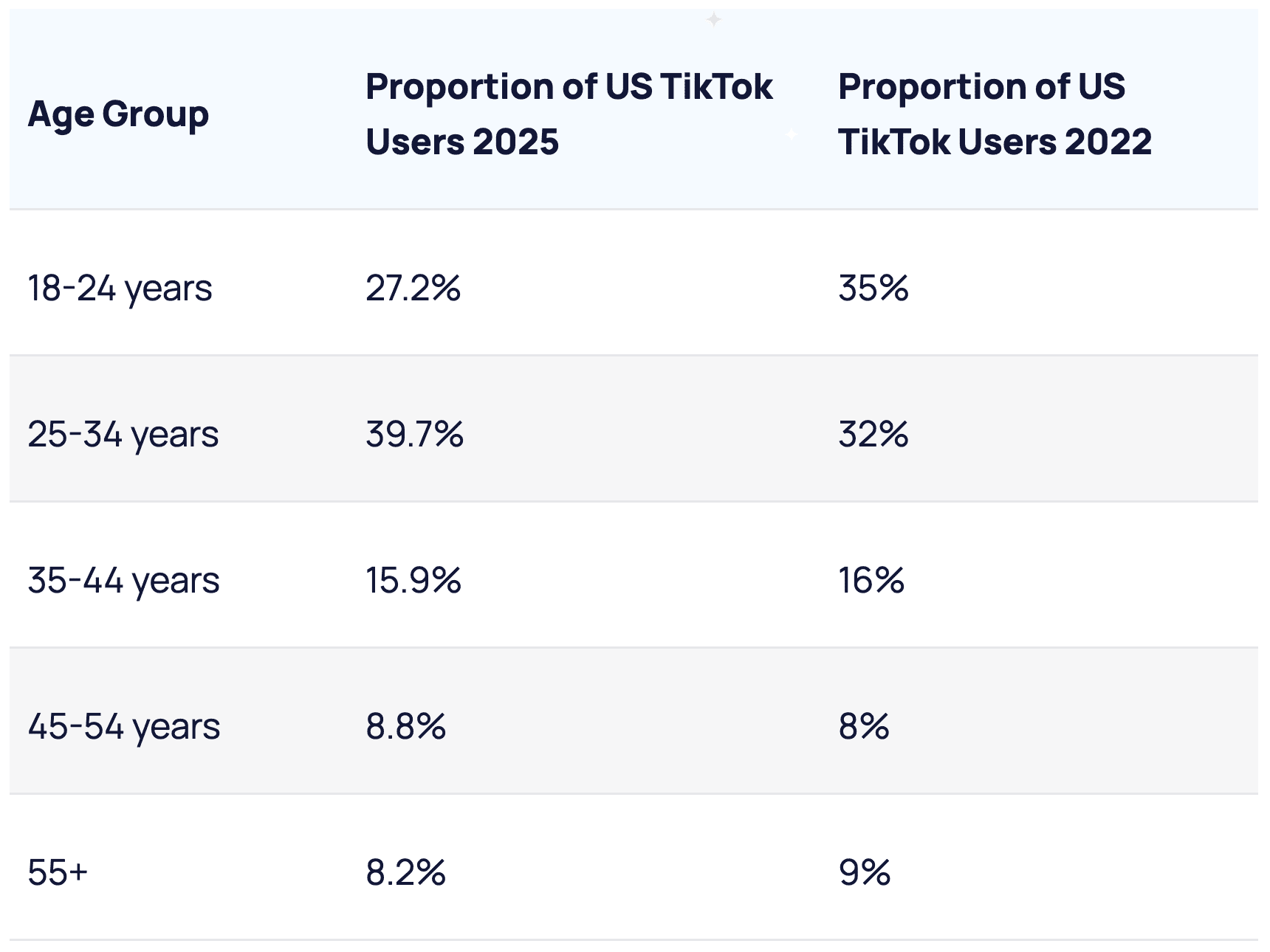
Source: Exploding Topics
Apart from having a huge audience, TikTok Ads are designed to blend into the user experience. Some sponsored videos appear natively in the “For You” feed, making them look and feel like regular content when you don’t make it too salesy.
And if you manage to create a “wave of UGC” for your brand, you’ll see the true power of TikTok.
Best use cases:
- No other channel engages younger audiences at scale like TikTok. Instagram would be the second one, but of course, it can't match TikTok.
- Viral product discovery through in-feed video ads. Very often, they drive sales even better when paired with trending topics or audio.
- TikTok rewards authenticity and creativity more than polished production, which means that you don’t need excessive resources.
- UGC campaigns. TikTok’s culture thrives on users recreating and remixing branded challenges while adding their own style or take on something.
Why it works: TikTok Ads benefit from the platform’s algorithm, which is designed to surface content (and ads) based on interests rather than follower count. That means a small business can achieve massive reach if its creative resonates with its target audience.
Of course, ad spend on TikTok requires testing, but the payoff can be really high. Businesses have seen sales explode overnight from well-timed campaigns that were “riding” trending topics.
6. LinkedIn Ads
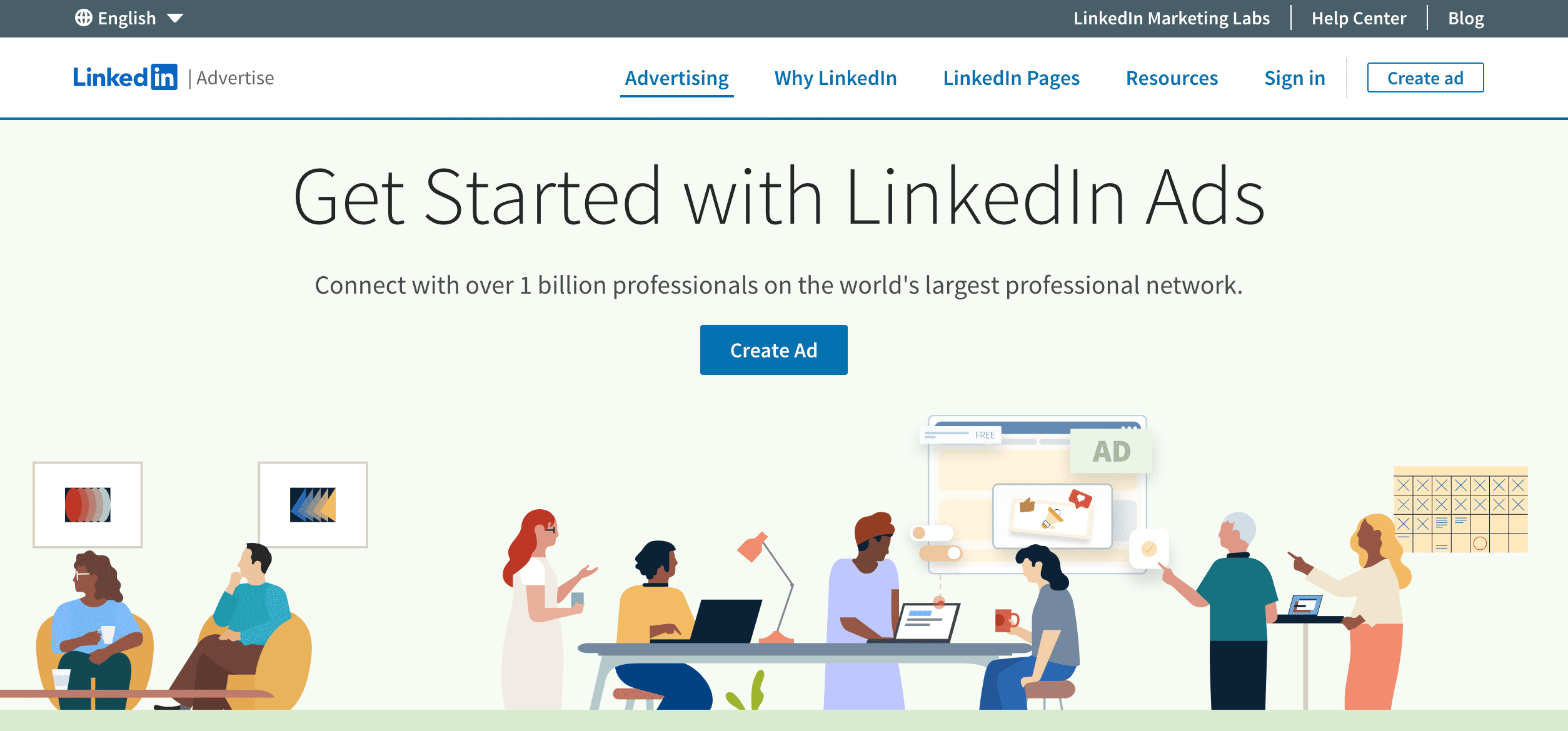
Source: LinkedIn
LinkedIn Ads are the go-to for reaching a professional audience. People on LinkedIn are there to network, learn, or look for opportunities. It’s one of the few ad platforms where targeting by job title, company, or industry actually makes sense.
According to LinkedIn data, they have over 1 billion members and more than 67 million company and organization pages.
When looking at the distribution of their user base by age, it might seem quite similar to pretty much any other social network.
Yet, typically, these people are different or at least their intentions are. So, despite the fact that over 70% of their audience is under 34, it’s one of the most effective channels for B2B advertising.
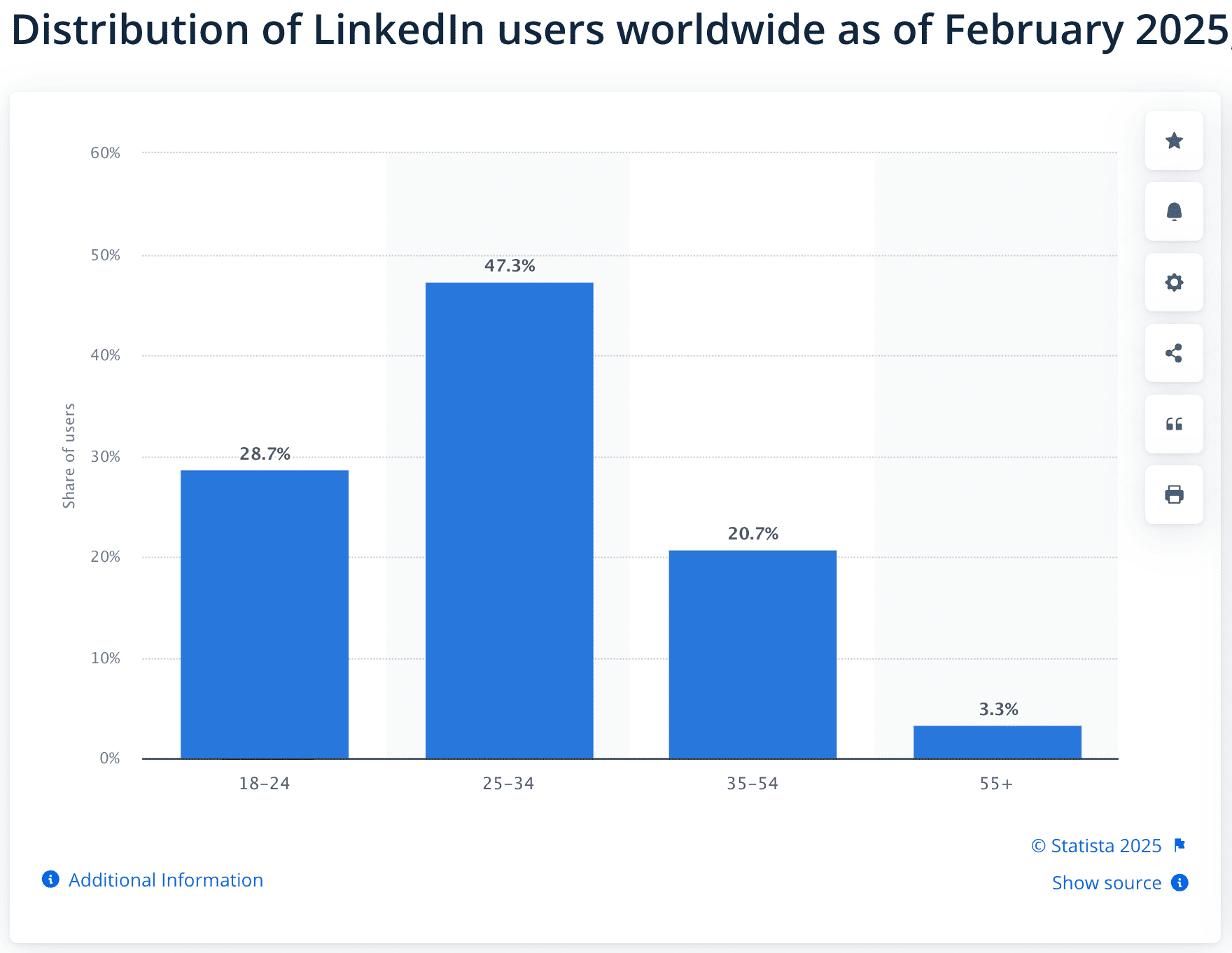
Source: Statista
Best use cases:
- B2B lead generation is the number one case. Target decision-makers directly by company size, industry, or function.
- Promote job listings to highly specific candidate profiles.
- Consulting, SaaS, training, or finance companies benefit most from the platform’s credibility.
- Event promotion is great for driving sign-ups for webinars, conferences, or professional workshops. We’ve explained this in detail in our webinar promotion guide.
Why it works: LinkedIn is famous for its targeting. In just a few clicks, you can establish a connection with CEOs or CMOs. However, it is definitely not the cheapest option. CPCs here are higher than on Facebook or Instagram. But the quality of leads often justifies the cost.
7. X Ads
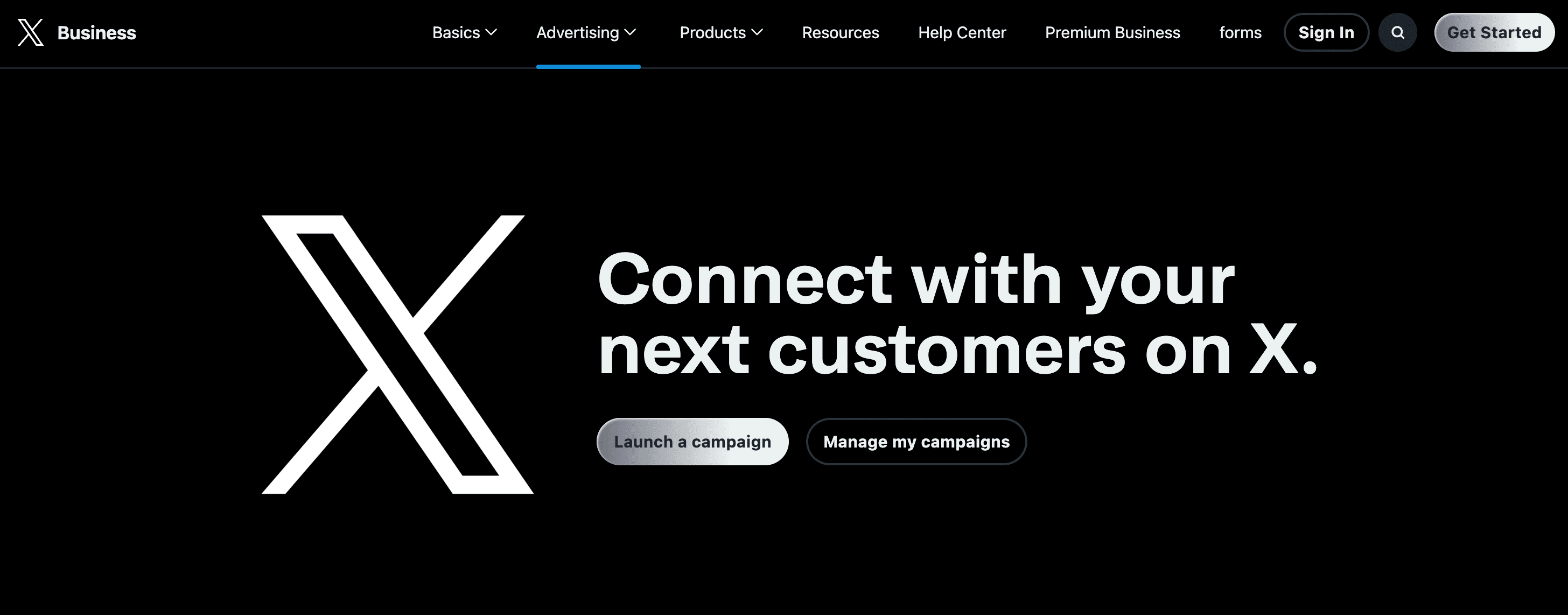
Source: X
If you want to drive traffic or generate leads, X could be a very useful tool. Here, you can share more up-to-date content or make some quick announcements.
You might say, all social media is good for that. Well, X offers instant interactions and real-time feedback. Besides, the audience is generally looking for timely-relevant content.
Speaking of the audience, you get a fair share of users in different age groups. And if you want to target male users specifically, X or Facebook could be some of the best choices among social media.

Source: Statista
Best use cases:
- Getting more visibility when live events are happening.
- Receiving quick feedback and sharing all the latest news.
- Running engagement-focused campaigns with promoted posts.
- Audiences here are information-driven and responsive to updates and insights. So, tech, crypto, and similar niches often choose X as one of the main solutions.
Why it works: X Ads thrive on speed and context. With keyword targeting and conversation tracking, businesses can run highly tailored campaigns. While normally, it isn’t the best platform for direct sales, it's powerful for thought leadership, visibility, and brand authority.
8. YouTube Ads
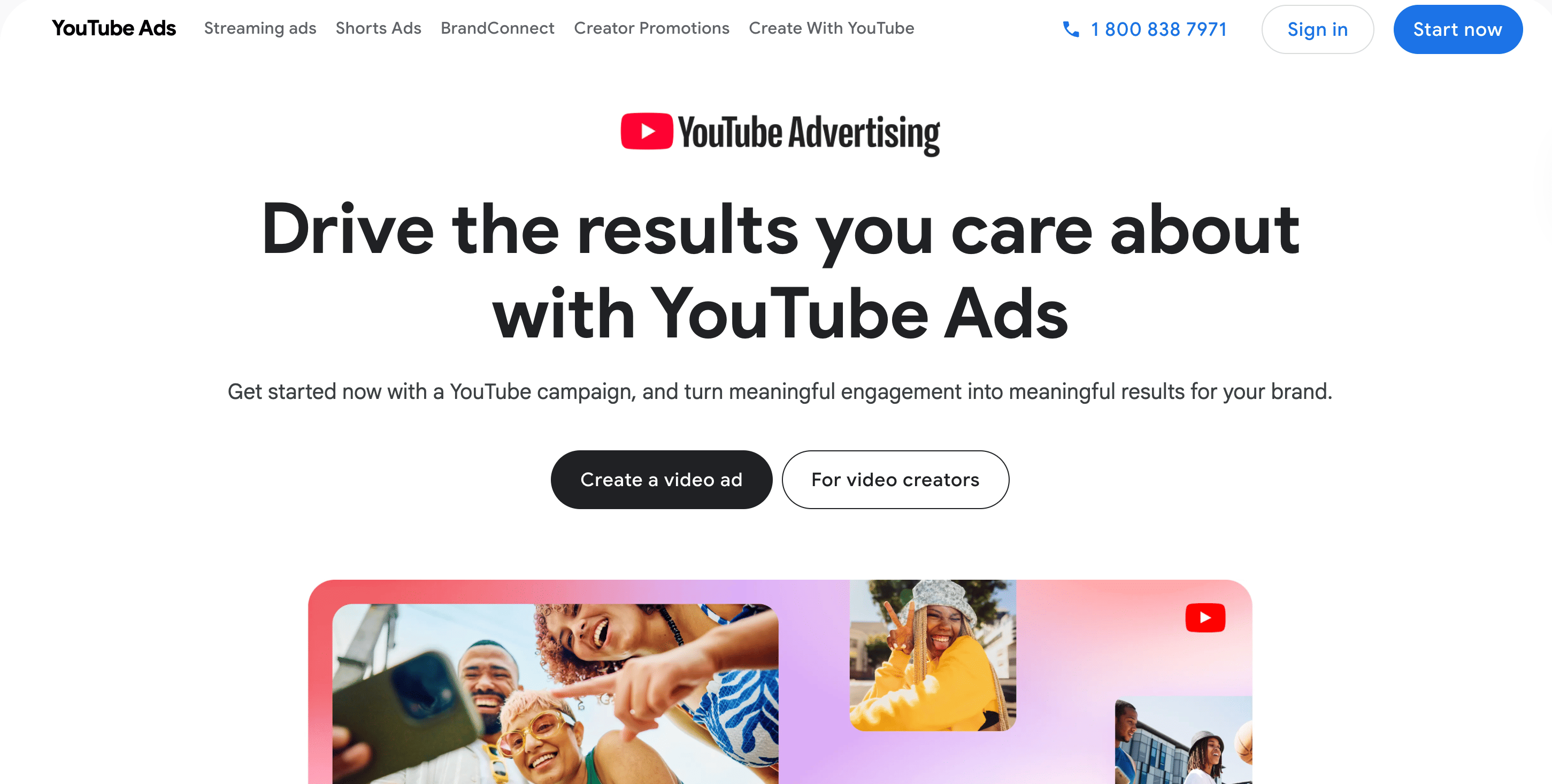
Source: YouTube
YouTube is more than just a social media platform. It is also a search engine. So, if you’re looking for a versatile place to advertise, this might be it.
Since YouTube is owned by Google, it integrates directly with Google Ads. That’s why you can have all-in-one campaign management and detailed analytics if you also run Google Ads.
With almost 3.5 million videos watched every minute on YouTube, it’s definitely one of the best places for video ads that educate or build brand recall. Besides, it has quite a well-distributed audience across all ages and genders.
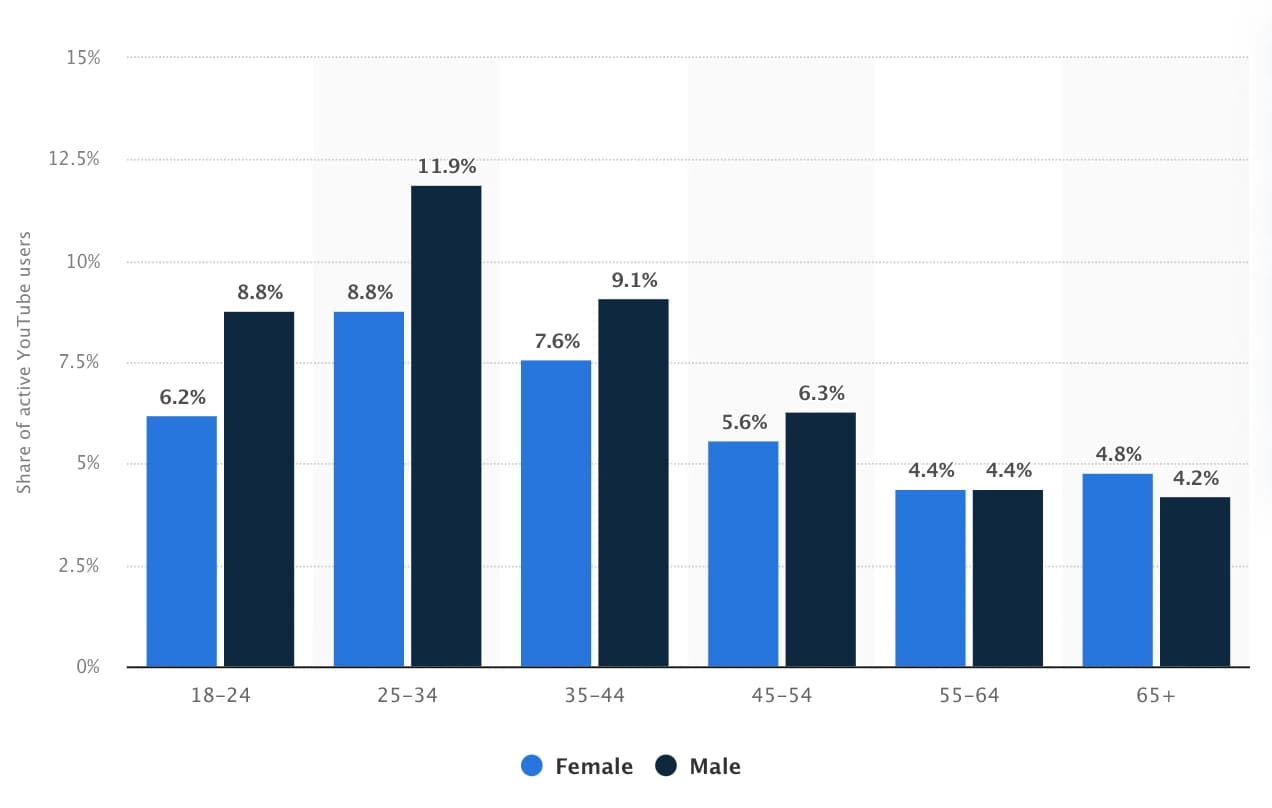
Source: Statista
Best use cases:
- Perfect for companies that want to show their product or service visually.
- Launching awareness campaigns because even short bumper ads can leave a strong impression.
- Establishing deeper contact with your audience compared to short-form content.
- Working on industry leadership and brand authority by showing your expertise.
- Product demos or explainer videos for what needs visual explanation.
- Retargeting could also work well here.
Why it works: YouTube offers scale and intent combined. People go there to learn, so your message can land at the perfect moment.
With tools like audience segmentation, keyword targeting, and custom affinity audiences, it gets even easier. Businesses can create highly targeted campaigns that match viewers’ interests and search behavior.
And because YouTube integrates with Google Ads, you can also analyze how your video campaigns impact traffic.
E-commerce and retail
If search advertising works with intent and social media builds awareness, retail media networks are where intent turns into sales.
These advertising channels connect brands with shoppers right at the point of purchase.
So, for e-commerce brands, retail media isn’t just an option. It is really one of the most logical places to allocate your ad spend. Let’s cover some of the most popular options.
9. Amazon
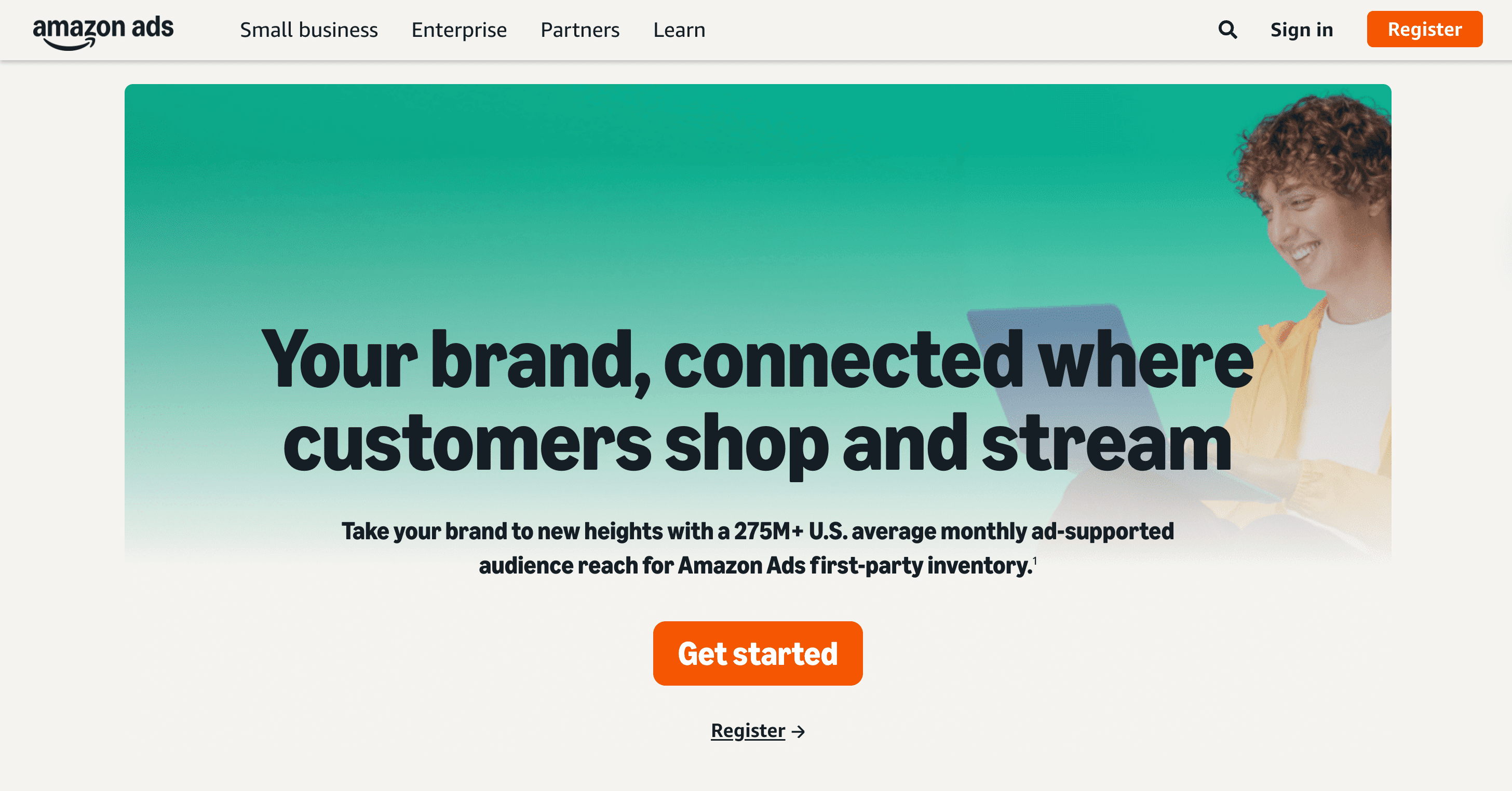
Source: Amazon
Amazon Ads is definitely one of the best advertising platforms in retail media.
With millions of daily product searches, Amazon has already become a proper search engine for shoppers. Many users go right away to Amazon when researching what to buy. There are many reasons for that: same-day delivery, tons of reviews, multiple sellers, etc.
Regardless, this popularity gives advertisers the advantage of capturing high-intent customers right before they make a purchase. Plus, there are multiple ad formats available. These include sponsored products, sponsored brands, sponsored display, and video ads.
Amazon Demand-Side Platform (DSP) also allows retargeting across the web and apps beyond Amazon itself.
Best use cases:
- Sponsored Products and Sponsored Brands help sellers stand out in competitive categories.
- Great for new brands starting to sell on Amazon.
- Brands can retarget and reach users who viewed their products but didn’t convert.
- Amazon video ads can position your brand in premium placements during shopping sessions.
Why it works: Amazon Ads tie directly to shopping behavior. You can track performance down to sales, revenue, and even share of voice within a category.
So, for businesses that sell physical products, Amazon Ads basically offer a closed-loop environment. You can track the whole customer journey from ad impression to the actual purchase, all within one ecosystem.
10. Walmart Connect
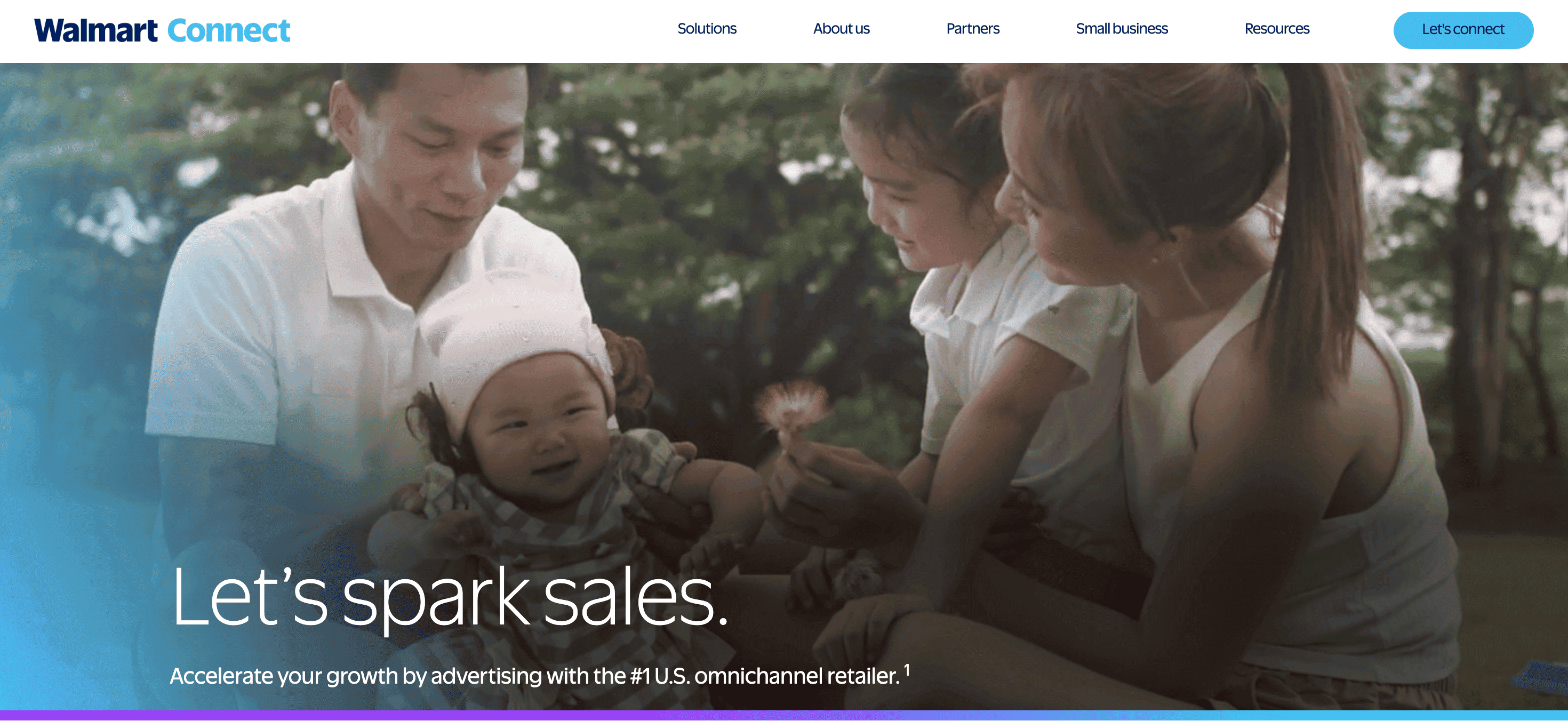
Source: Walmart
Walmart Connect is Walmart’s retail media platform. It gives brands a chance to advertise across Walmart.com, the Walmart app, and in-store digital displays. That’s why they advertise as “the #1 U.S. omnichannel retailer”.
Similar to Amazon, Walmart also offers closed-loop measurement. You can easily track ad exposure and both online and in-store sales, helping you understand actual ROI.
It may not have Amazon’s scale, but Walmart’s physical presence and household reach might be a real game-changer for some brands.
Best use cases:
- Consumer goods and grocery brands that sell through Walmart’s online and offline ecosystem.
- Omnichannel campaigns, thanks to multiple promotional channels.
- Walmart’s data allows location-specific targeting tied to store inventory.
Why it works: Walmart makes online and in-store advertising work together. How many platforms have you seen doing something like that?
Brands can reach customers as they browse products online, or as they physically walk the aisles. This hybrid model makes Walmart Connect especially powerful for consumer goods and retail brands.
11. Instacart
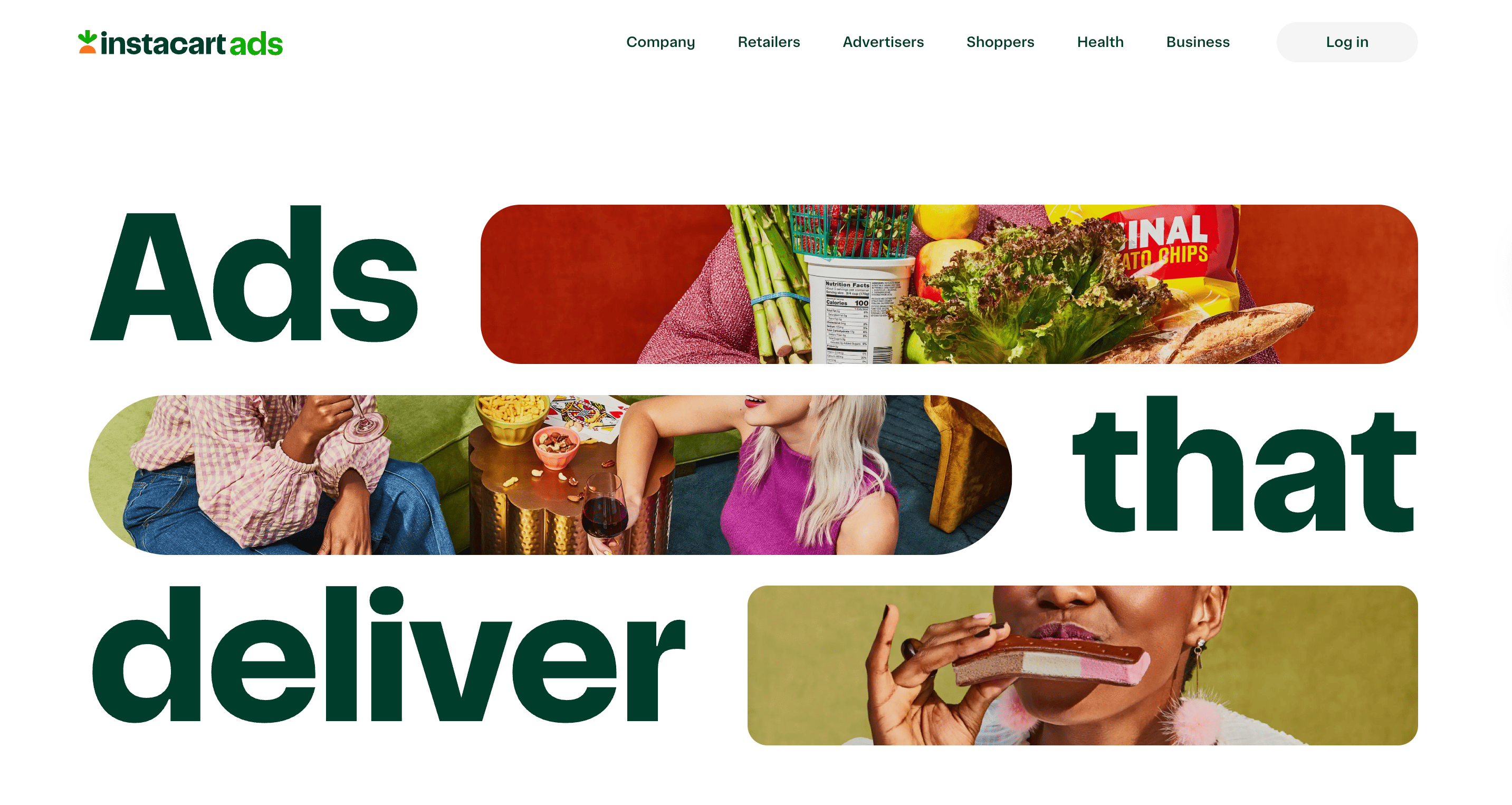
Source: Instacart
Sure, Instacart Ads aren't as big as Amazon or Walmart. But it’s a part of a big new trend: the booming grocery delivery market. And their user base keeps growing.
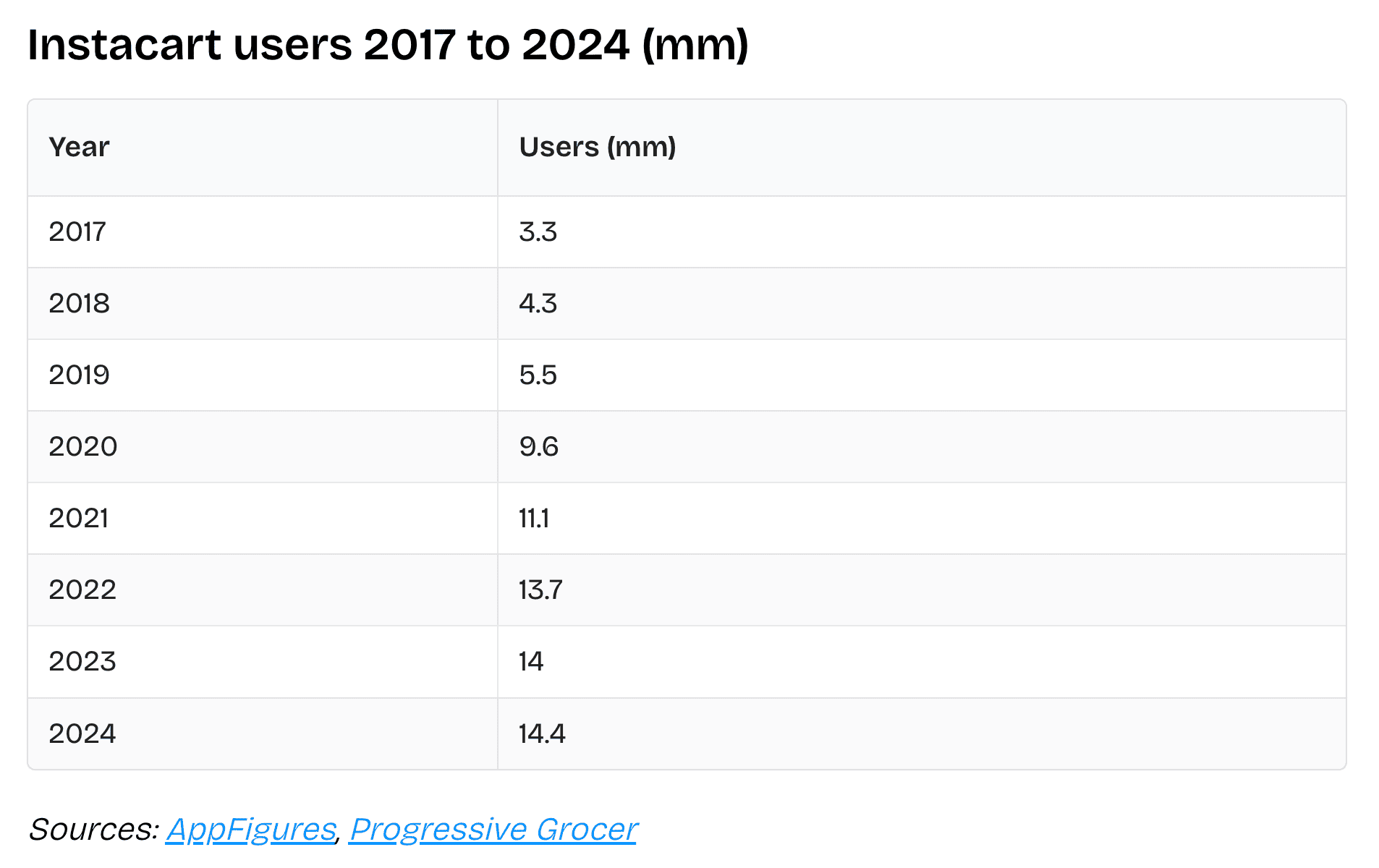
Source: Business of Apps
Instacart offers a variety of ad types: sponsored product ads, promotions, a whole page dedicated to your brand’s products, display ads, shoppable display ads with “add-to-cart” option, and shoppable video ads.
You can also try Instacart’s off-platform offerings that help you reach your audience across other channels like web, social, streaming TV, and search. All these can ultimately help you drive more sales and promote your brand.
Best use cases:
- B2C brands that want to have top-shelf digital placement next to their direct competitors.
- Upselling and cross-selling techniques are easy to implement.
- Localized reach is available when you use a ZIP code.
Why it works: To put it simply, people are already in purchase mode on Instacart. And while buying, they can just see your ad. Instacart’s analytics is also very clear and intuitive. So, you can easily test your ads, adjust bidding, etc., all inside one ad manager.
12. eBay
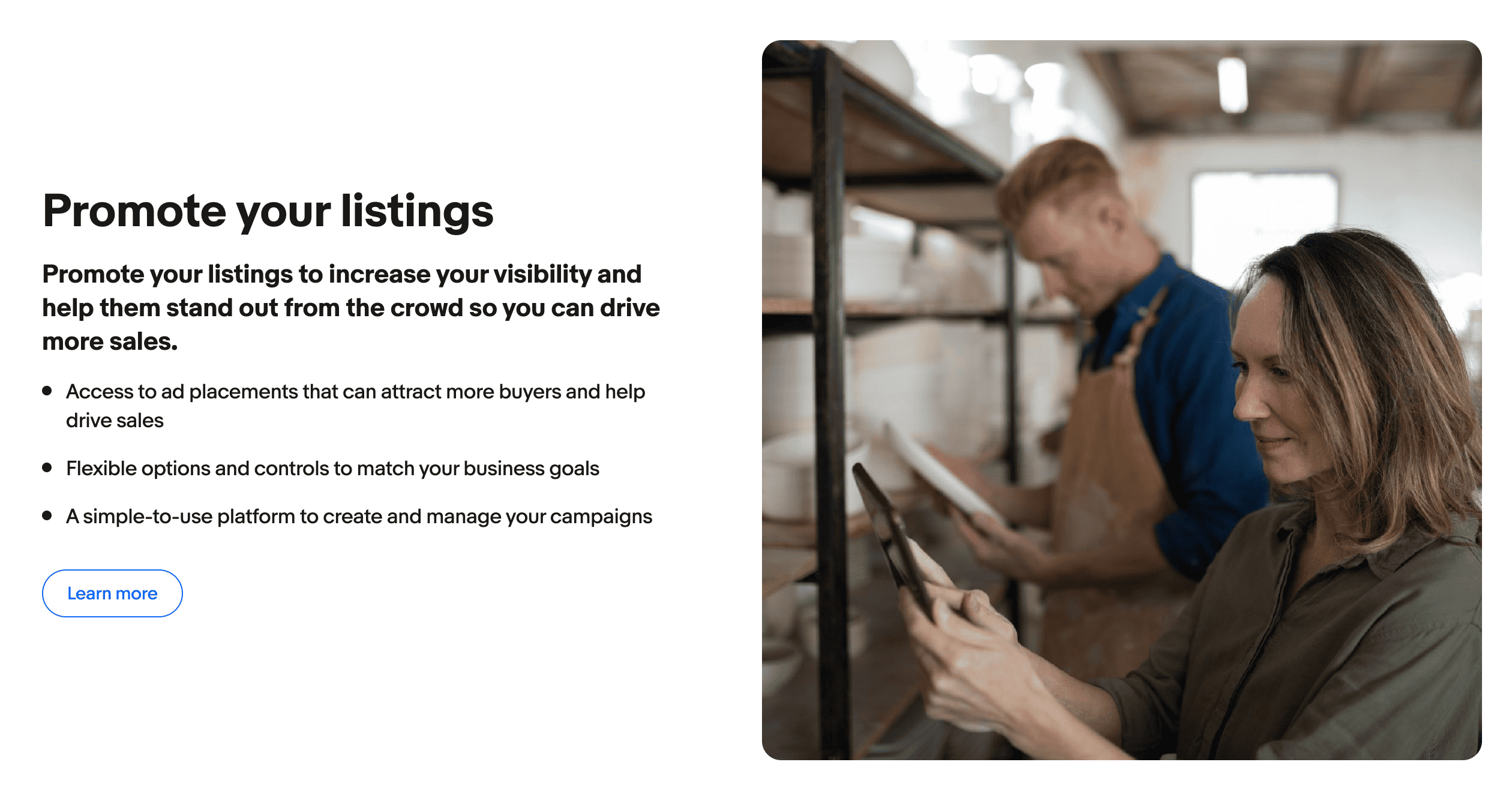
Source: eBay
Most likely, eBay isn’t your first choice when it comes to PPC. No wonder… But while eBay is probably one of the oldest online marketplaces, its advertising part keeps evolving.
eBay Ads offer sellers the ability to boost product visibility across search results and category pages. Yes, it is not Amazon or Walmart. It is hard to compare the scale here. But it serves a unique audience of value-focused and niche-product buyers.
Best use cases:
- Niche or collectible products, such as vintage, electronics, or automotive.
- SMBs and resellers get an easy setup with transparent pricing and flexible budget control.
- Global reach is possible through eBay. You can easily reach an international audience for cross-border sales.
Why it works: Campaigns are simple to set up, and you only pay when your promoted item is clicked or sold (depending on the model). For small businesses or resellers, it’s a good chance to increase traffic without deep ad management expertise.
Niche options
Niche ad channels aren’t obvious. But it doesn't mean they aren’t effective. On the contrary, smaller, community-based websites have conversations going on. And often, it’s one of the best places to advertise your business.
You might be surprised, but these days researching and discovering often go beyond Google. That makes Reddit, Quora, and Pinterest powerful advertising solutions. Still, you have to approach them with the right message and tone. Let’s see what that means.
13. Reddit Ads
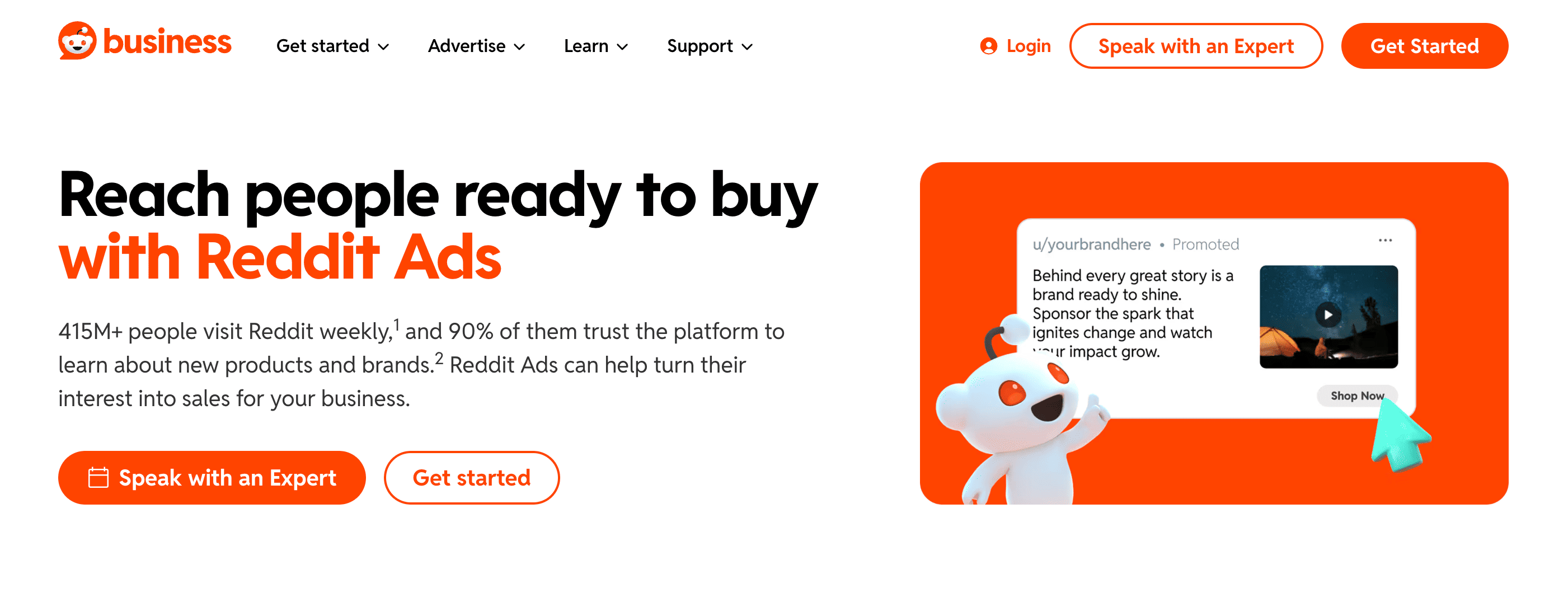
Source: Reddit
The first thing you need to know is that Reddit is built around communities. There are thousands of active subreddits where people share their opinions in all kinds of niches. So, advertisers can place messages in spaces where users are highly knowledgeable about a specific topic.
This clear focus is what makes Reddit one of the most effective advertising platforms.
Besides, ever since the $60 million Google-Reddit deal, you’ve probably noticed Reddit threads showing up more often in search results and featured sections. It was the deal where Reddit gave Google access to train its AI on community posts.
But of course, one of the biggest advantages of this channel is its audience. Reddit users value authenticity. While it's anonymous by default, people there very quickly smell any weird stuff.
Redditors actually trust Reddit.

Source: Reddit
To make it work, though, you have to understand the style of this "forum". For example, overly polished, corporate messaging never performs well here. In fact, it could turn into a disaster.
Sure, all this authenticity is often a torture for Reddit marketers, but it gives you a whole different quality of leads.
Best use cases:
- Niche audiences live here. Tech, crypto, gaming, lifestyle, or professional subreddits give you access to your perfect customers.
- You can start thoughtful conversations and discussion-friendly promoted posts, so it can help boost your credibility.
- Reddit is generally very good for testing reactions to new product ideas before a full launch.
- You can even use ads to start conversations around your brand, niche, etc.
Why it works: Reddit Ads give you a chance for interest-based targeting with a very good level of precision. You can advertise directly to a subreddit like r/PersonalFinance or r/Fitness. So, there is really no need to guess at broader audience segments.
It’s also one of the few social media platforms where engagement quality outweighs follower count.
14. Quora Ads
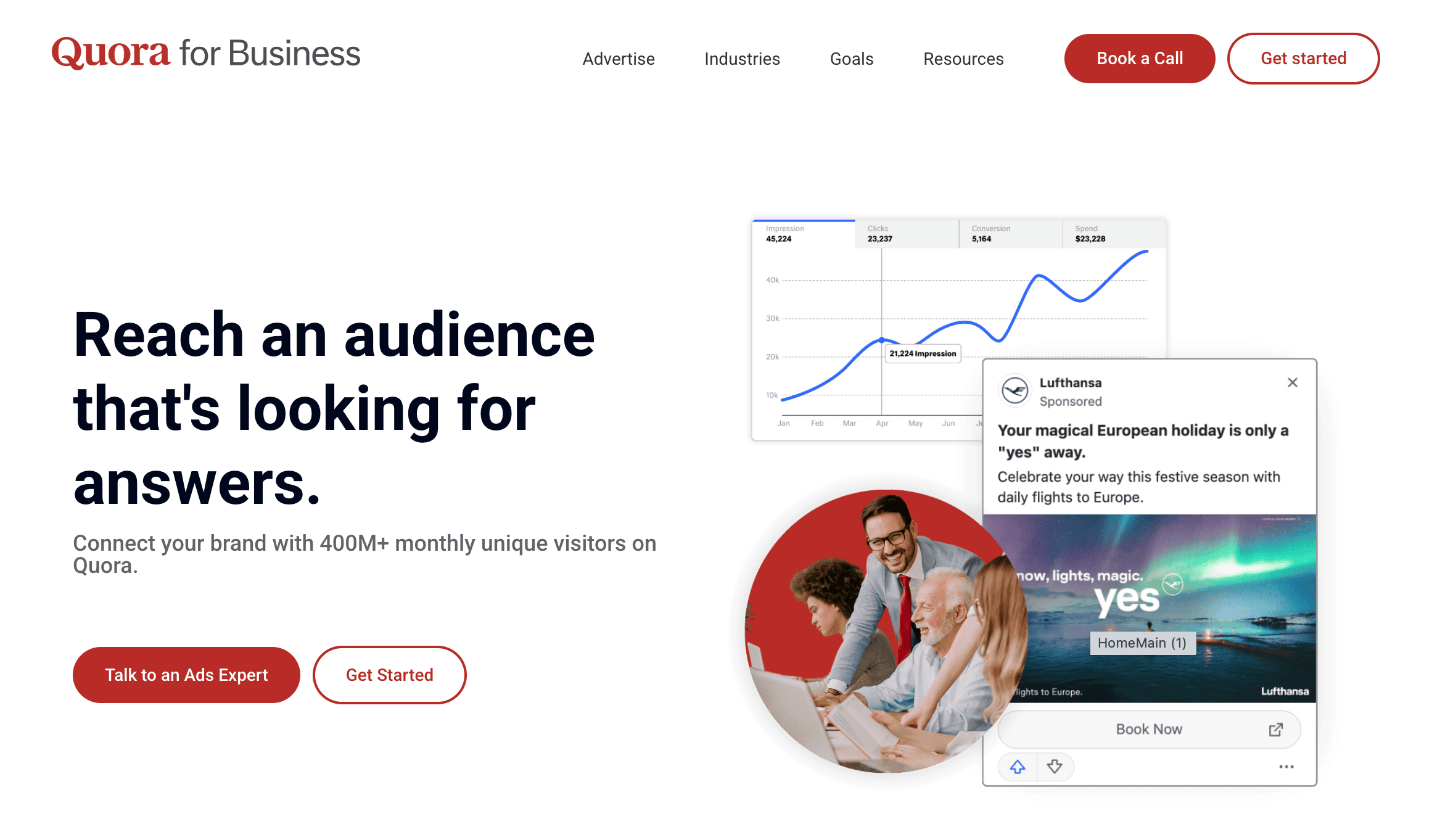
Source: Quora
Quora sits somewhere between a social network and a search engine. Typically, users visit it to ask and answer questions. So, it is a good environment for brands that want to educate and influence users at the research stage of the customer journey.
But you can also get direct signups for your website, subscribers for your newsletter, traffic to high-value pages, etc.
While it isn’t the best channel to sell something directly, it can work great to get slightly warmed leads by presenting your product/service as a useful solution to someone’s question.
Best use cases:
- Explaining complex services or solutions, which is good for B2B.
- Give answers that demonstrate authority within an industry.
- It is historically good for audiences researching “best options” or “how to choose” topics.
- Lead generation might not be obvious, but it works. Besides, Quora’s lead gen forms integrate great with major CRM systems.
Why it works: Quora Ads target users based on the questions they read or ask. For a brand, there is a chance to be there for potential customers at the exact moment they’re seeking solutions.
That makes Quora especially effective for businesses that rely on trust and expertise to convert.
15. Pinterest Ads
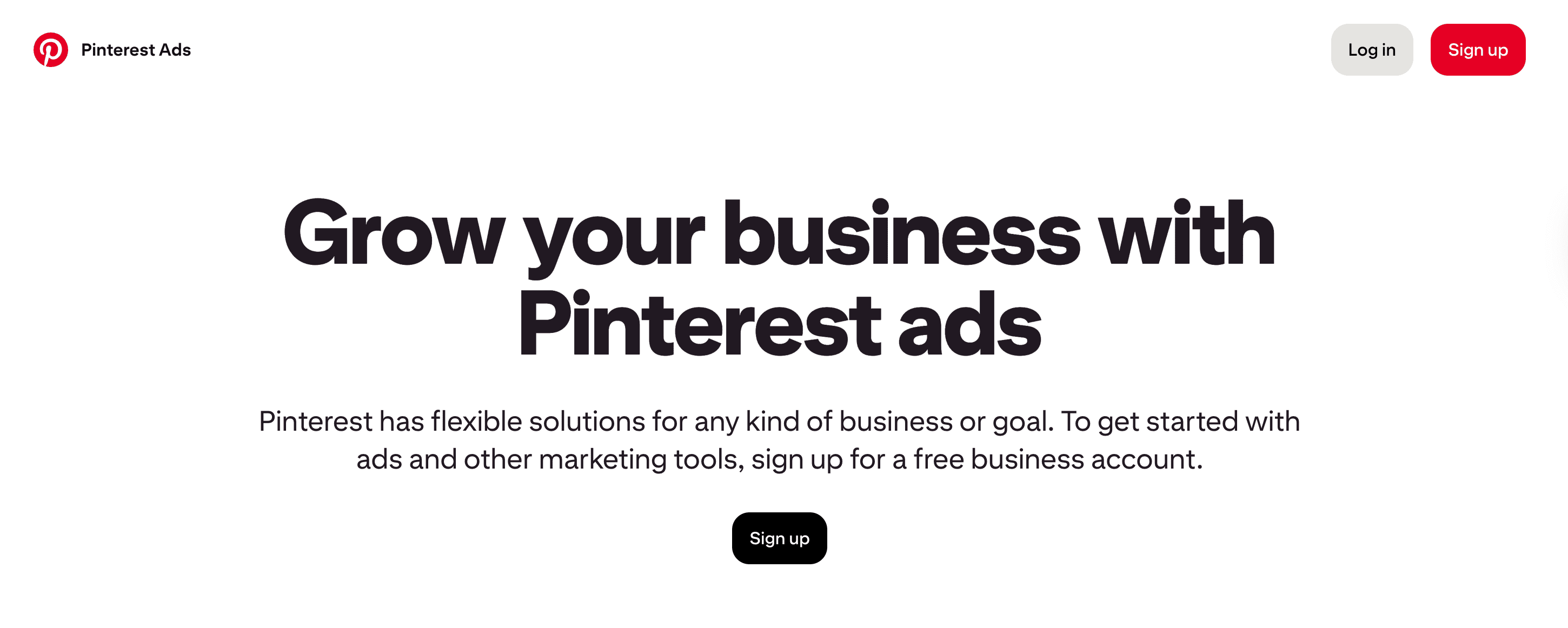
Source: Pinterest
Pinterest is quite often seen as an aesthetic platform. Well, it certainly is. But it is also more than that. Pinterest is essentially a place where users go to plan, visualize, and save ideas. That makes it one of the most underrated advertising solutions for e-commerce and lifestyle brands.
Think about this: in most traditional social media, ads feel like an interruption. But smart Pinterest ads often inspire. They feel like a part of the discovery process.
Sure, it isn’t for everyone, but it can be a great option if you’re a B2C brand that’s visually appealing. It could also be especially effective if you want to mostly target a female audience.
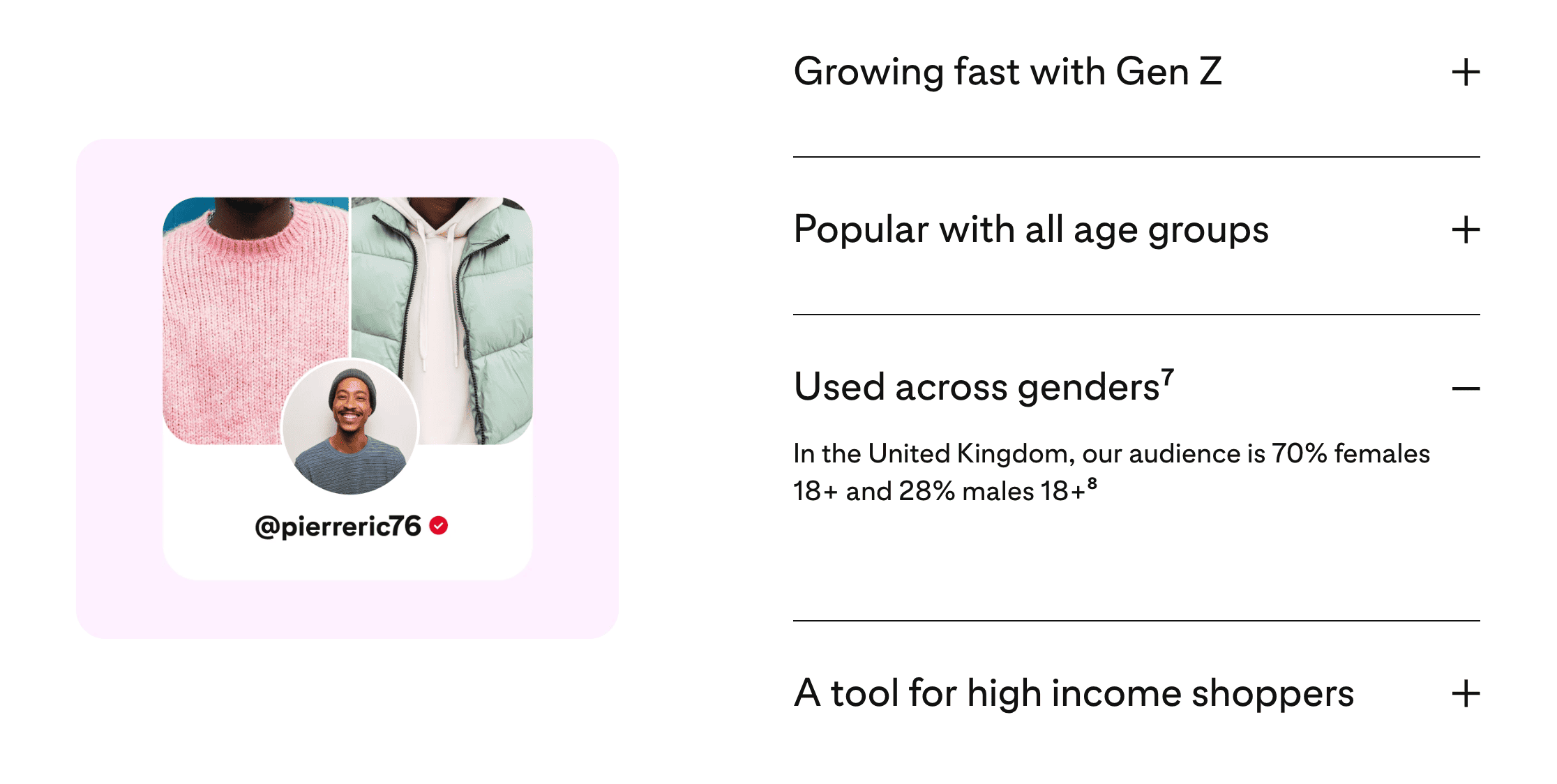
Source: Pinterest
Best use cases:
- All visually driven industries.
- E-commerce: since users are already exploring some products, shopping ads tend to convert well.
- Great for blogs, recipes, guides, or lookbooks that drive soft conversions.
- Holiday gift guides or event inspiration boards perform very well.
Why it works: Pinterest users often come with high intent. They’re planning purchases, projects, or lifestyle changes. Ads here don’t need to hard-sell; they need to match the aesthetic and provide value.
Because of this, Pinterest Ads often yield strong ROI for brand discovery and top-of-funnel engagement.
Other
While search, social, and retail platforms take most of the spotlight, a few “other” channels are shaping how brands can stay visible online.
While these options might not be as saturated (especially the messengers), they still require clever targeting to work well.
16. Display (Google Display Network)
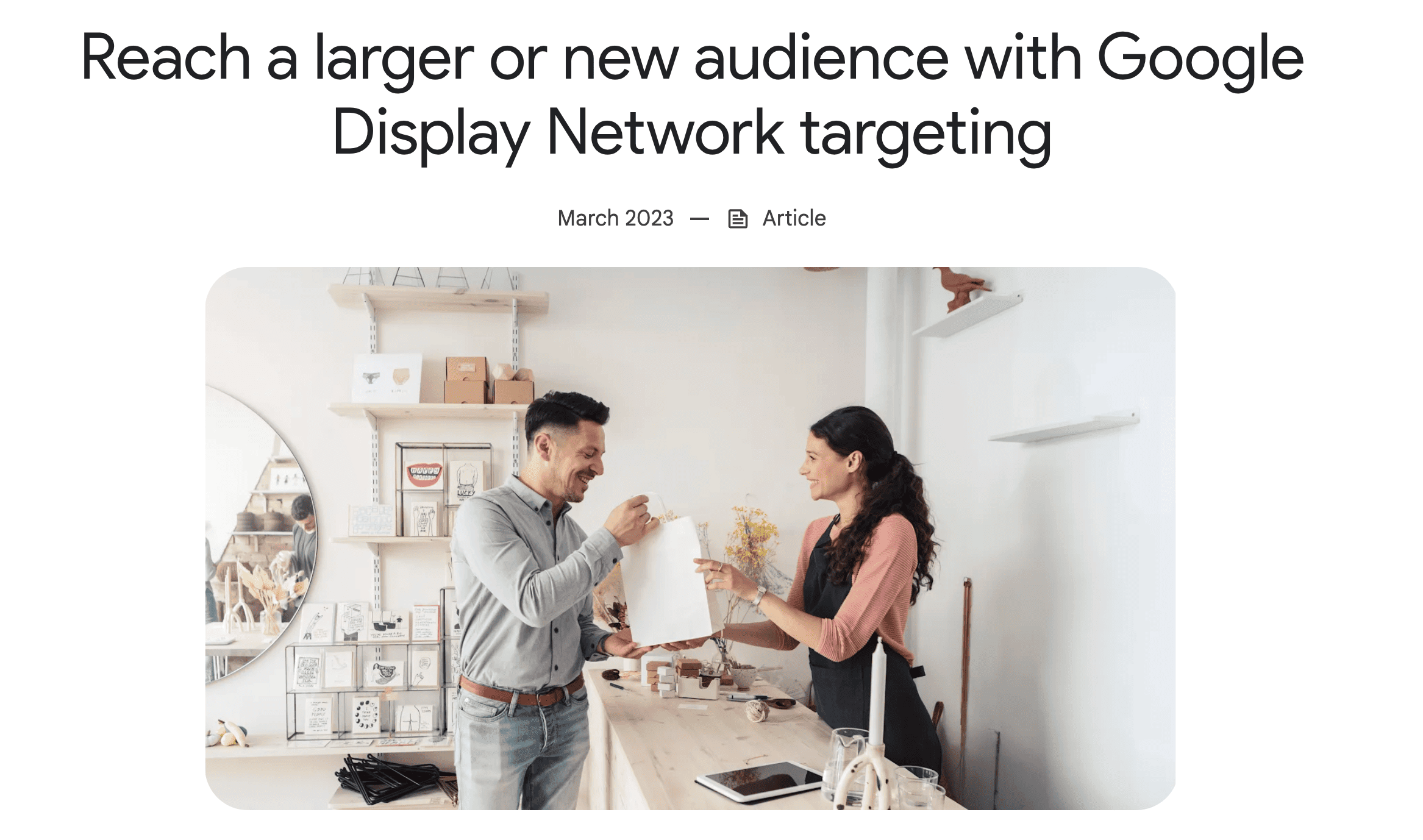
Source: Google
The Google Display Network is reaching over 90% of global internet users across millions of websites, apps, and videos. It is not relying on keywords like in Google Search, though.
GDN connects your ads to audiences based on context, interests, or behavioral signals. It’s kind of a more intuitive approach, if you will. Besides, you can use Google’s AI to optimize your placements and bids.
Best use cases:
- Visual storytelling, product launches, or seasonal campaigns.
- You can retarget and remind visitors who’ve already interacted with your website or app.
- You can receive more top-of-funnel visibility, as you get in front of new audiences before they start searching.
Why it works: The GDN offers massive scale and flexibility. You can tailor placements to specific topics, sites, or customer segments.
17. Messengers
Messengers are the new big thing for digital advertising. They’re personal, conversational, and embedded into how billions of people communicate daily.
The space is still relatively young, but adoption is growing really fast. So, you can experiment with it while it’s still “fresh”.
Here are just a couple of the most popular options.
Meta Messaging Ads (Messenger + WhatsApp)
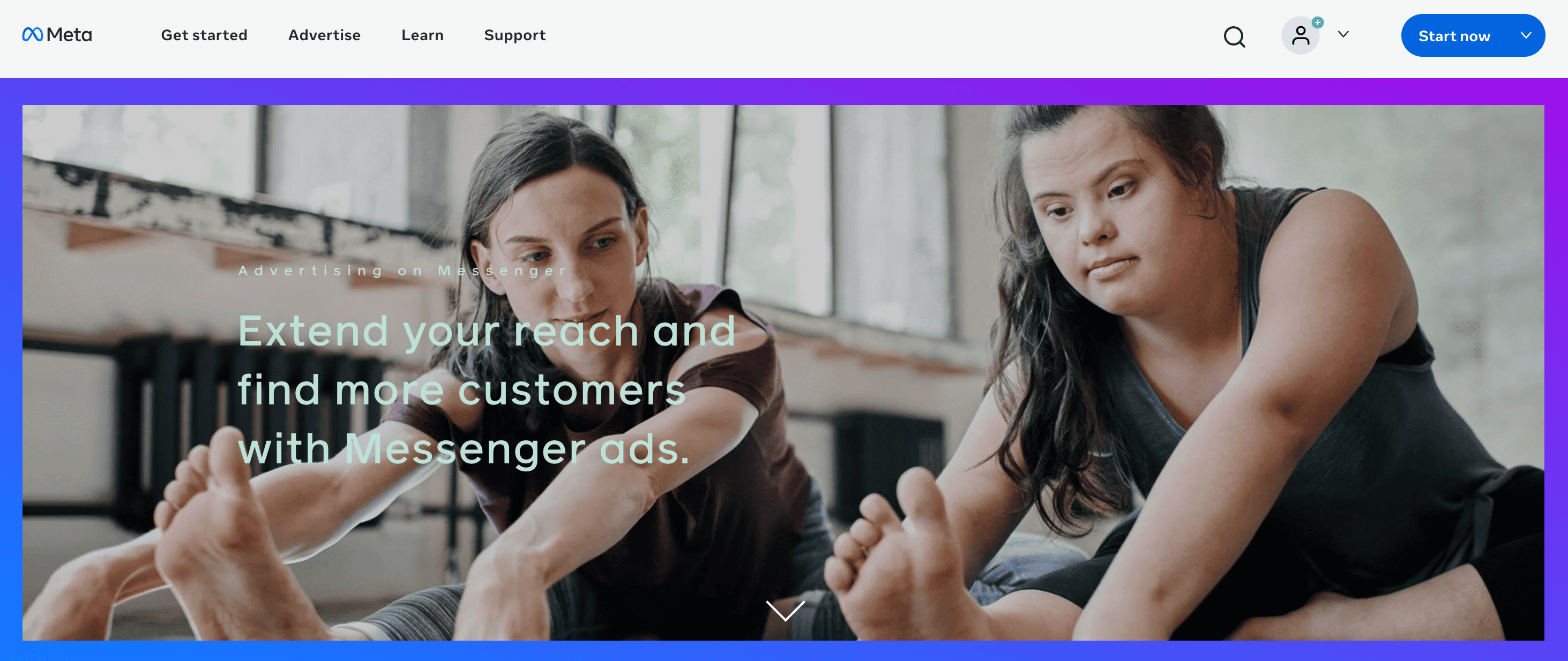
Source: Meta
Meta is one of the main players here. Ads can appear directly within chat lists or open new message threads with automated responses.
Businesses can use them for lead generation and abandoned cart reminders. Besides, doing direct sales through in-app conversation flows could be a good idea.
Telegram Ads
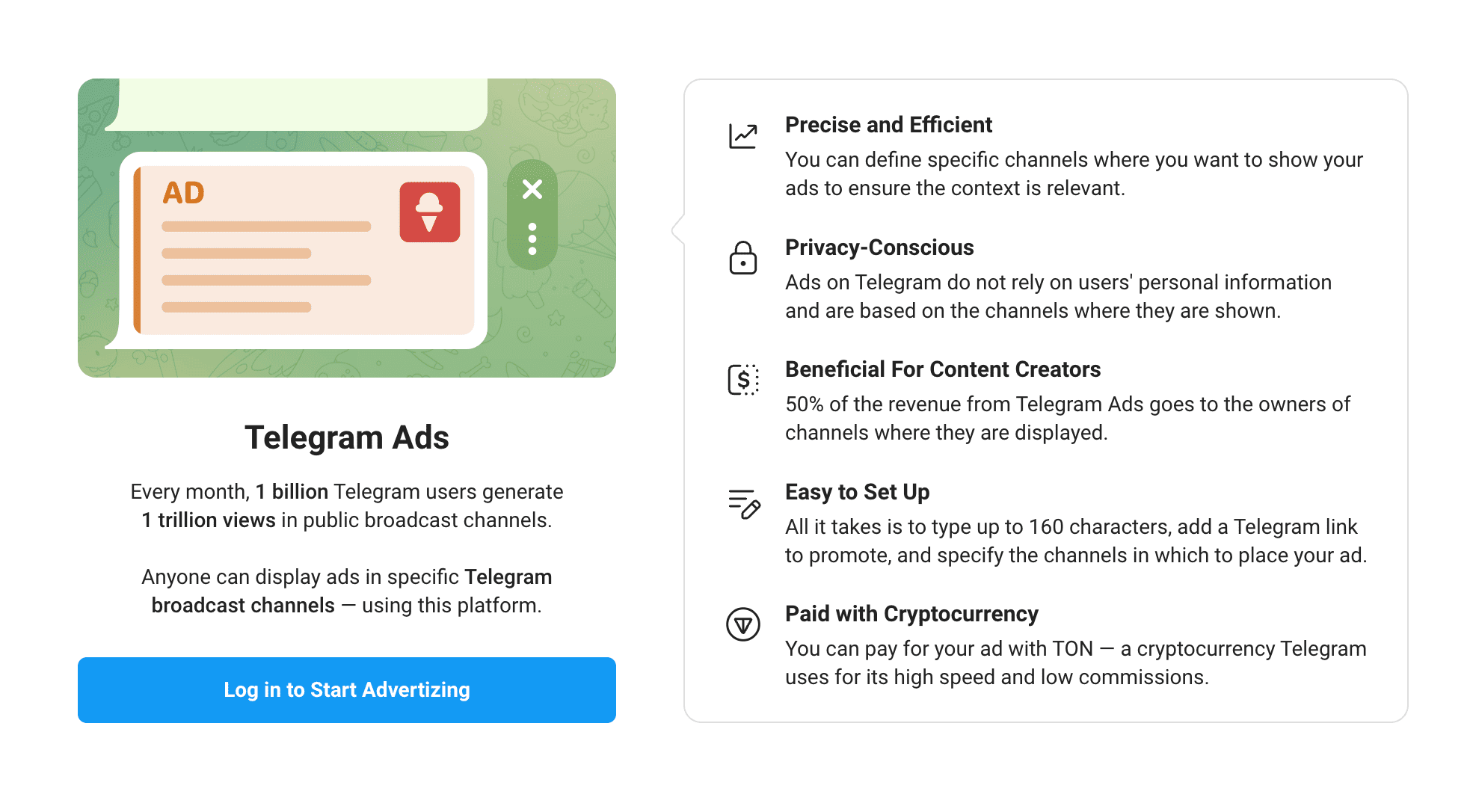
Source: Telegram
Telegram launched its ad options quite recently, but with strict limits. For example, only channels with more than 1,000 subscribers can host ads, and creative options are minimal.
While Telegram Ads aren’t too advanced and the messenger’s audience is also limited in many regions, it could be an option for some businesses, depending on your location.
WeChat Ads & LINE Ads
Both WeChat and LINE are extremely relevant in Asia. They offer full-funnel advertising, which isn’t too hard to manage. So, if you want to target Chinese and/or Asian audiences, these are the options you want to keep in mind.
Why it works: Messenger ads meet audiences where they’re already most active. So, conversion rates are often strong because users feel like they’re engaging with a person.
It’s a small but growing segment. And many marketers believe that it’s likely to become central to personalized and conversational marketing over the next few years. That’s why it could be a great tactic to explore if you’re looking for some expansion.
What is the best advertising platform?
By now, you probably understand that there is no universal answer for this. It really depends.
Just looking at the options above and their capabilities may give you some understanding of what is a good one for you. Still, if you feel a little overwhelmed with all the variety of ad channels out there, consider the following things when making your choice.
Start with your business goals
Every marketing activity should start with assessing your business objectives. It is a foundation for everything you’ll be doing later. Each goal you’re after points to a different set of options. For example:
- Sales and direct conversions: Google Ads, Meta (Facebook/Instagram), and retail networks like Amazon or Walmart Connect.
- Brand awareness: YouTube, TikTok, and the Google Display Network.
- B2B lead generation or hiring: LinkedIn Ads or Microsoft Ads with job title targeting.
Of course, it isn’t that black and white. But overall, this is quite a typical approach that works for millions of businesses.
Analyze your audience
…otherwise, nothing will work.
Where does your target audience spend time, and what is their mindset? Gen Z can discover your product ads while actually looking for entertainment. But if your goal is to reach B2B decision makers, looking for them on TikTok is a much less logical decision.
Make sure you understand the demographics and at least basic purchase behaviour of your audience. This is one of the major factors for picking your marketing channels.
If you want to make this even more effective, create a detailed buyer persona and maybe even a negative buyer persona. This will help you find proper messaging, hooks, objections, and other aspects that actually make people choose or ignore certain products/services.
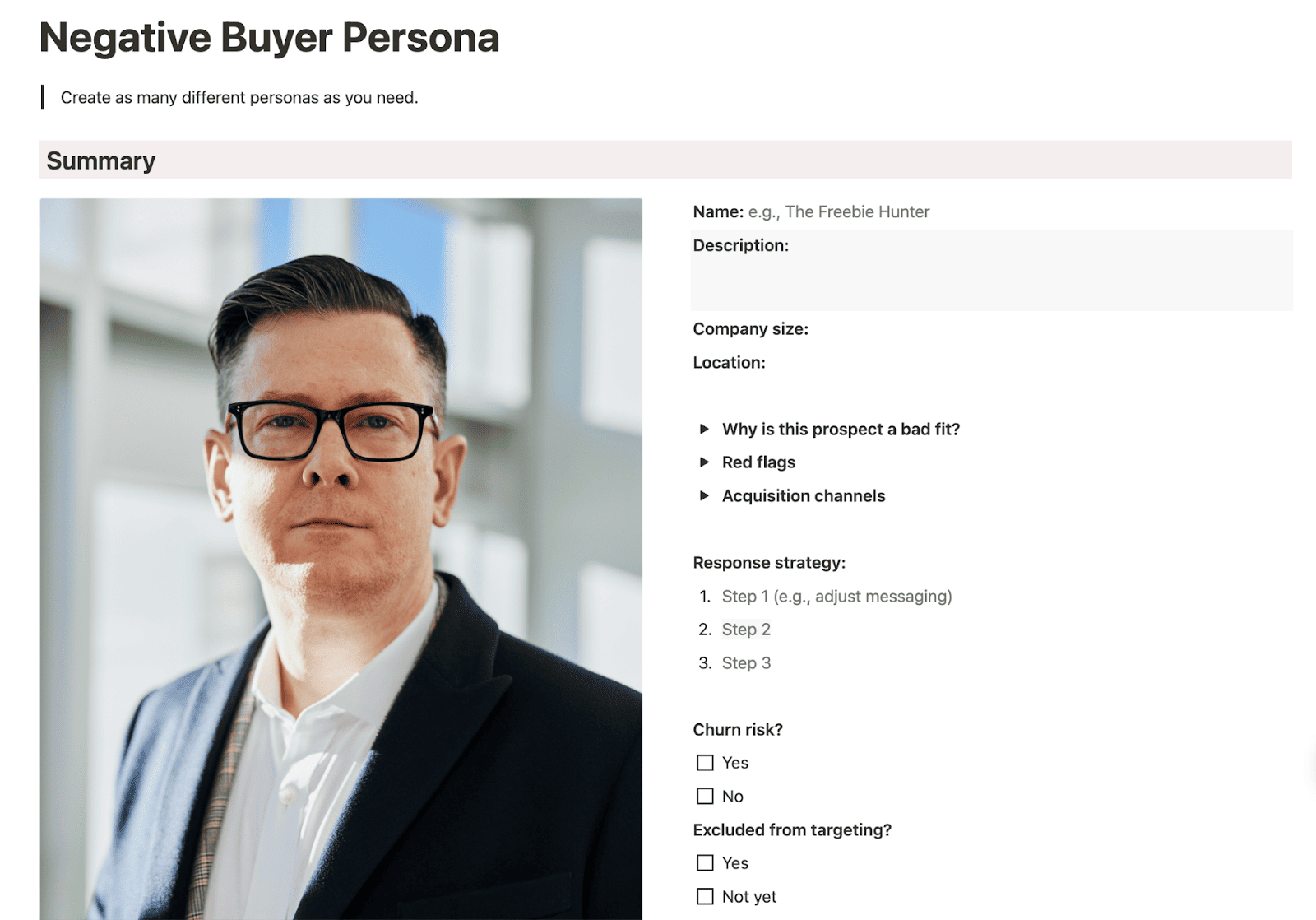
Consider your budget
Some channels (like LinkedIn Ads, for example) have higher CPCs but target narrower, high-value audiences.
TikTok or Meta Ads can reach large audiences at lower costs. But they might not be as precise (depending on your targeting, of course).
Overall, budget-wise, a good rule is the following:
- When working with small ad budgets: Start with one or two channels that show measurable ROI. For many businesses, it’s the classics, Google Ads or Facebook Ads.
- When having larger budgets: Expand to secondary platforms like YouTube or LinkedIn once your core campaigns perform well.
Review your creative resources
Each channel demands different ad formats and creative assets. There are image ads, carousel ads, dynamic shopping ads, video ads, text-only campaigns, etc.
So, it’s really important to remember these two things:
- Make sure your content feels natural to the channel you use for promotion. People on TikTok and Facebook, generally, expect different angles and formats.
- Work on your messaging regardless of the platform you choose. Often, your ads don’t work not because you use the wrong channel, but because the content isn’t persuasive enough. Maybe people simply can’t identify with what you’re saying. So, it’s very important to test different messages before experimenting with channels.
Conclusion
Now, you know about the most popular and most effective advertising platforms. But as we’ve already mentioned, it doesn’t mean that you need to try them all.
While all these choices might seem truly overwhelming, it doesn’t have to be like that. Start by choosing channels that work for your business goals and your audience. Next, test the waters a bit and adjust your creatives. And soon, you’ll find a perfect combination for your brand.



